Entertainment
NIGERIA AT 62: REMINISCING ON THE GROWTH OF NIGERIA’S MUSIC INDUSTRY
Published
2 years agoon

When Veno Mariaghae prophesied it nearly four decades ago, most people might have dismissed her words as wishful thinking.
The Delta songbird’s prayers on her 1985 bop dubbed, Nigeria Go Survive, still manifest deeply into the existence of this great country. It has been a 62-year-long adventure filled with twists, travails and triumphs.
Veno’s prayers might have not fully come to fruition in every facet of the country, but within the Nigerian music industry, there have been monumental leaps of growth. From a child of circumstance, struggling to find a voice, the Nigerian music industry has grown from just a mesh of tribal sound systems into one giant ecosystem that has now become the soundtrack of the world.

In this Guardian Music Independence Day special, we are taking a kaleidoscopic view of some of the monumental eras, landmarks, and figures that shaped the growth of our beloved music industry.
Rise of indigenous popular music
THE sweetness of indigenous music, from both the Eastern and Western climes in Nigeria, was almost as intoxicating as the palm wine itself that was the main staple in social settings where they were championed. Already, Babatunde King’s Juju music had already been a noble genre, which was played across pre-colonial Nigeria at that time. Yet, there were some scintillating voices emerging such as Dr Victor Olaiya, Roy Chicago, and Rex Lawson, among others, ruling the highlife scene in Lagos, Nigeria’s entertainment capital.
Within the Southeast, the Osita Osadebes, Oliver de Coques and the Oriental Brothers were also chiefly involved in popularising the highlife genre. Other highlife stars such as Roy Chicago blazed a trail with his slew of hits such as Iyawo Pankeke, Are owo ni esa Yoyo gbe, and Keregbe emu. He was also arguably the first musician to blend the talking drum into highlife music. Victor Olaiya’s International All Stars and Roy Chicago’s Abalabi Rhythm Dandies were two of the leading highlife bands in Nigeria, both led by graduates of the Bobby Benson Orchestra.
The ‘60s and ‘70s were such a beautiful era for indigenous music in Nigeria. Within the South Western region, Haruna Ishola became the stuff of legends. The musician was the best performer of apala, a percussion-based style that started in the 1930s as a wake-up call to the Islamic faithful during the month of Ramadan. Ishola was known for performing lengthy shows to massive audiences in Osogbo.
In 1971, two years after he started STAR Records with I.K. Dairo, he released Oroki Social Club on Decca Records, an ode to the popular nightclub that hosts his performances in Osogbo. That album sold over five million copies and became his largest selling record till date.
Nonetheless, indigenous genres started to take a nosedive during the ‘70s and early ‘80s, with the Nigerian Civil War (1967-1970) pushing highlife’s mavericks into other genres including Juju music. Adherents like Victor Olaiya kept the fight going strong with his series of ‘revival’ concerts, which were held at the Papingo Nightclub of Stadium Hotel, Lagos and even an album dubbed, Highlife Giants of Africa. Still, highlife faced its eventual decline.

Disco-funk and Rock Evolution
WHILE Highlife was battling its decline; and Juju and Apala music were still flourishing with that anxiety of ‘who is going down next?, a few musicians were experimenting with Afro-funk, creating varieties of electronic music that were silently taking over dance clubs in Nigeria.
Joni Haastrup’s Greetings; SJOB Movement’s A Move In The Right Direction, Bongos Ikwue and the Groovies’ You’ve Got To Help Yourself, and T-Fire’s Will Of The People were profound records that proved Nigeria’s mettle in the realm of Disco Funk. Drenched guitars, jazzy trumpets, flailing flutes and heavy percussion of Disco Funk dominated this sort of ‘alternative’ genre.
Conversely, Nigeria’s rock scene rose mostly from university campuses shortly after the Nigerian Civil War, and the bands came from all over the country but were especially common in the East. The members of BLO (it was an acronym of their first names) had played with Ginger Baker in Europe for a few years, as had Joni Haastrup, with his rock band called, Mono Mono. These were two of the country’s biggest rock bands. Other bands such as Ofege, and their Higher Plane Breeze album provided one of the Nigerian rock scene’s iconic images.
Many other names like Tunji Oyelana, the Funkees, Ofo the Black Company, The Hygrades, Colomach, Tabukah ‘X’, The Elcados, and many more were all lost from memory due to Nigeria’s horrid legacy of not keeping good archives.
Fela Kuti and Afrobeat
THE musical mad scientist, Fela Anikulapo-Kuti, is another proud beam of Nigeria’s musical legacy. After he broke into the Nigerian music scene, in the ‘60s, with his Koola Lobitos band, he began to gain prominence. However, it was his 1969 tour of the United States that bootlegged his drive for activism, after being exposed to the work of Malcolm X, the Black Panthers, and other militants.
With his band, which was variously known as Nigeria 70, Africa 70, and later Egypt 80, he churned out an increasingly politically-charged discography. Songs like Roforofo Fight, Zombie, Sorrow, Tears and Blood, and many others.
To date, Fela Kuti is the most influential singer that has ever created popular music. His style of music, a melange of Jazz, funk, and its own distinct drum patterns became a spectacle of admiration globally. It would later influence musicians down several generations, whose creolised fusions are collectively categorised under the moniker, Afrobeats.
Streaming Platforms, COVID-19, Social Media and Global Awards
THE dawn of the millenia ushered in a new era of music, where American Hip-Hop and Rap were fast becoming household sounds. RnB, too, began to dominate radio plays and dance clubs. Everyone was hooked on Destiny’s Child, Mary J Blige, Mariah Carey, Ja Rule, Ashanti, 50 Cent, and many more.
It didn’t take long before stars like Plantashun Boiz, The Remedies (Tony Tetuila, Eedris Abdulkareem and Eddy Remedy), Styl Plus, Eedris Abdulkareem, Sound Sultan, and Lagbaja began to lead their era with Afro RnB and Hip-hop, which became the popular music of that time.
Soon, the Ajegunle boys such as Daddy Showkey, Daddy Fresh, Baba Frayo, Marvelous Benji, Mad Melon & Mountain Black, African China, and others started fusing elements of music from other West African climes, popularising sub-genres such as Makossa, Konto, Galala, among others. The music was hard to categorise, at the time, with its very native appeal. There were stars like Pasuma and Obesere who were still holding the forte with Fuji music. However, these newer genres and fusions ruled the scene.
Interestingly, the 2010s brought in the biggest change to Nigerian music. As of then, more access to technology helped Nigerian musicians create better music videos. From The Mo Hits crew to Storm Records, the EME Crew and other major music collectives, or superstars, it was the era of shooting music videos in foreign countries. The video qualities were crisp and very attractive.
It was also the era of major music-based TV stations such as Channel O, MTV Base, Hip TV, and SoundCity TV, among others. The industry was becoming more localised, with all facets of the ecosystem being represented in the country – from production to marketing and distribution, to performances. It was a good thing, while it lasted. Now, the industry is fast-becoming Westernised, and for good reason too. But that is discourse for another day.
The 2010s also brought the experiment of streaming platforms. looking was the forerunner of the business. After seeing the digital explosion happening, and the accelerated movement of local listening habits from CDs to mobile consumption, the company swung into action to create a product.
Founded in September 2010 with headquarters in Lagos, Nigeria it offered a range of online media products, including its movie streaming website named iROKOtv focused on Nollywood Film productions, and ‘brokering’, a Nigerian music streaming platform. While cooking was short-lived, other music platforms – all owned by foreign companies – started to slowly crawl into the Naija music sphere. The likes of Apple Music, YouTube Music, Audiomack, Boomplay, and more recently, Spotify, all came on board. And this catapulted our music scene to greater acclaim.
With the streaming platforms came more elaborate charting systems that helped with cross-continental music discovery. Music lovers in other climes were now discovering Nigerian musicians via playlists. And the diaspora black community strongly became hooked on Nigerian music. The streaming revenue from this has been meteoric. For instance, Ckay’s Love Nwantiti has raked in more than one billion naira from streaming royalties alone.
Then came the COVID-19 and social media era. This current generation of music creators has enhanced possibilities with marketing their music today. It is also quite easy to discover new talent today. From Adekunle Gold, to Reekado Banks, down to Ayra Starr, to Mayorkun, and many others, artistes are now getting discovered by posting freestyle videos on their Instagram or Twitter pages.
When the COVID-19 pandemic struck, we were all taken by surprise in Nigeria. Nationwide lockdowns forced concerts and disco floors to be shut down. Musicians were stuck at home and not performing on stages. It only meant one thing; more music. And with creative ideas such as Instagram live challenges, between music producers, musicians and so on, the internet kept everyone busy. And this era changed our consumption of music permanently. Nigerians became more voracious listeners, and musicians started to seriously consider creating music for more markets beyond the Nigerian industry. This is where Wizkid comes in.
In the middle of the pandemic, he released an album dubbed, Made In Lagos, which till today is one of the best-selling African albums of all time. Songs from Made In Lagos, such as Essence, attracted the entire diasporic community, with big stars including Rihanna, Jay Z, Chris Brown, and even former US President Barack Obama all giving their applause on the Terms-assisted song.
The current music industry space is also a more profitable scene thanks to social media. With the rise of entertainment platforms such as TikTok, Triller, YouTube shorts, Instagram and Twitter, it is easier for artistes to create trends with their music. You’d hardly see any song, today, being released without a dance challenge or some routine being used to promote it on TikTok. We even witnessed extreme routines, many of which were not spearheaded by the musicians themselves but the artistes, such as the Joeboy’s Alcohol challenge, where people kept pouring cooking oil, liquid soaps, and bottles of alcohol on their bodies. However, it has helped with a global explosion of these songs.
You see songs like Oxlade’s Ku Lo Sa, currently going viral in literally every region of the world. Thanks to social media. It’s easier to track views and gain more insight into the stats of your listeners. It is helping show promoters better understand consumer behaviour and know the right types of artists to bring to specific regions.
Lastly, global award shows such as the Black Entertainment Television (BET) award, as well as the Grammys, have also become another laudable point in our music history.
While they were not the first Nigerians to be nominated, Wizkid and Burna Boy became the first two Nigerian-based musicians to win big awards. Wizkid won, in 2021, for his contribution to Beyonce’s Lion King: The Gift album, while Burna Boy won in the same year for his Twice as Tall album, which earned him the Best Global Music Album.
The BETs had previously been won by artists such as Wizkid, Ice Prince and Davido, and had always been closer to home, but the Grammys were seen as the holy grail of music worldwide. And this is a US-based award; that’s the legacy you get for 64 years of consistently celebrating musicians.
Other African award platforms like The Headies, Soundcity MVP Awards, and the All Africa Music Awards (AFRIMA) have equally tried to fill the void within the country. But these platforms are all young, and it will definitely take them a bit of time to reach the Grammy’s acclaim.
While 62 years might seem like a long time, for the marathon of achievements that the Nigerian music industry has made it definitely is something to be cheerful about.
Currently, with the exports of Nigerian music under the aegis of Afrobeats, the Grammys have started contemplating creating an “Afrobeats” category at the awards.
Billboard has created a dedicated charting system dubbed, Billboard Top 100 Afrobeats. Wizkid, Burna Boy, Ckay, Asake, and many more are selling out monumental venues in Northern America and Europe. And literally, every British or American superstar wants to collaborate with Afrobeats/Nigerian artists.
After 62 years, we are enjoying more general exposure, increased access to opportunities, better technology for production and distribution, a decline in music piracy, ridiculously high streaming numbers (or song plays), and dominance of worldwide music charts. After 62 years, Veno was right about us. The Nigerian music industry is here for the long run. And it can only get better.
Phone: +2348029115783
WhatsApp: +2347037611903
Follow us via:
Facebook: @Words and Shots
Instagram: @words_and_shots
Twitter: @wordsandshots
You may like
-


COBHAMS ASUQUO: I’LL NEVER STOP EVOLVING WITH MY MUSIC
-


PRETTY OKAFOR BREAKS 40-YEAR JINX, ACQUIRES CORPORATE EDIFICE FOR PMAN
-


MAVINS MARKS 10TH ANNIVERSARY WITH NEW ALBUM
-


ONE-YEAR ON: P-SQUARE REKINDLES ROMANCE WITH FANS
-


POLITICIANS CAN’T DO WITHOUT ENTERTAINERS —ZAAKI AZZAY
-


BUHARI’S INDEPENDENCE BROADCAST EMBARRASSING, SAY NIGERIANS

The people of the beautiful Coal City, the capital of Enugu State, Nigeria, will today be treated to a colourful and sumptuous event celebrating the rich culinary culture and practices of the people.

Enugu as the regional capital of the South East of Nigeria that is home to the Igbo ethnic group, is a melting point of the Igbo culture. It is home to all Igbo as well as a large chunk of people from other parts of the country, the African continent and indeed the world.
Thus, from the core indigenous menus to the influence of the cuisines imported by the settled population of visitors, Enugu offers a wide range of tastes coming from its kitchens. This is what Enugu food festival seeks to celebrate.
However, according to Ike Ezeugwu, whose Hillheights Media Solutions is behind the event, the time has come for the real indigenous tastes, in foods and beverages, to be singled out for celebration. The people must be redirected towards the kitchen where the iconic Enugu foods are prepared and accorded it’s place of pride.

Ezeugwu acknowledged that foods like Abacha, Echicha, Okpa, Ayaraya, etc, and the ever popular palm wine, were already well known. However, Enugu food festival will definitely make them more acceptable, especially to the younger generation whose kitchen knowledge are not as diverse and traditionally inclined as was desired.
Food, he said, as an important part of a people’s culture should be a familiar culinary art, habit and practice, transited inter-generationally. And what can only guarantee that is when local staples and diets are given prominent slots on the menu, as Enugu food festival is intended to do.

The event will feature food talks bordering on safe food practices, food sampling, cultural displays, games, performances, networking, among others. Professor Charles Ishiwu, a food processing specialist from Nnamdi Azikiwe University Awka, will be the guest lecturer. He will be talking about Food Safety and Food Malprocessing.
The event is holding at Amadeo Events Centre, Enugu. Red Carpet call time is 5 pm. Meanwhile, tables are still available for reservations.
Phone: +2348029115783
WhatsApp: +2347037611903
Follow us via:
Facebook: @Words and Shots
Instagram: @words_and_shots
Twitter: @wordsandshots
Entertainment
MICHAEL JACKSON MAY BE THE GREATEST MUSIC VIDEO ARTISTE
Published
5 months agoon
November 14, 2023
Perhaps Michael Jackson’s most significant achievement came with videos.

Michael Jackson may be the greatest music video artiste. Like magazine covers, Grammys, and radio, Michael Jackson’s plan to overcome colour barriers was, simply, to do something so good that MTV couldn’t resist it. When he saw the canal and the nascent art there for the first time, he was fascinated but felt it wasn’t close to the potential it had.

“At that time,” he later wrote, “I looked at what people were doing with video and I didn’t understand why so many seemed primitive and weak. I saw children watching boring videos and accepting them because they had no alternatives.”
In fact, most music videos at that time were simply presented as promos or commercials. They typically featured some kind of montage of images or live performances. Jackson envisioned something different: he wanted to tell a story.
Michael’s first opportunity to realize this vision came with Billie Jean. With a then exorbitant budget of $75,000 paid by CBS, Jackson and director Steve Barron created a small masterpiece. There were the dance steps, of course: spins and twirls. However, it was the total transformation of cinematography and the mystery of the narrative that really impacted
MTV initially refused to air the video, citing its policy of only airing rock music. However, the president of CBS, Walter Yetnikoff, who had released a huge amount of money for the video, in addition to the interest of promoting the Thriller album, did not accept the refusal of his biggest artist. “I told MTV, ‘I’m pulling all our artists,’” Yetnikoff recalls. “’I won’t give you one more video. And I’m going to go out to the audience and tell them about the fact that you don’t want to play a black guy’s music. ‘”
MTV relented and would quickly put Billie Jean into heavy rotation due to audience demand. With that decision, the walls crumbled.

After the success of the Billie Jean video, Jackson upped the ante with Beat It. For this song, he had a specific concept in mind. He wanted the anti-violence message to be taken literally, but he didn’t want to be soft or didactic. To execute his vision he hired talented commercial director Bob Giraldi and brilliant choreographer Michael Peters. He also insisted on filming the videos on the streets of Los Angeles rather than in a studio. When CBS refused to pay for the budget, Jackson provided the money, his own.
The result was the most revolutionary and influential music video that MTV had broadcast up to that point. Inspired, in part, by the Broadway musical West Side Story, Beat It showcased both grace and courage. The group choreography, with Jackson leading in his iconic red jacket, became the blueprint for countless music videos to come.
Beat It was approached with a level of realism and ambition that made it completely different from other music videos of the era. The final product was original, provocative and innovative. MTV played the video even more than Billie Jean, as ratings continued to climb. The short film would go on to win numerous awards and honours, including Best Music Video of All Time, from Rolling Stones readers and critics. It, too, put the final nail in the coffin of MTV’s reluctance to play black artists.
And then came the video for “Thriller.” From the beginning it was treated more like a feature film, with an unprecedented budget of $500,000 (a number that would balloon to almost 1 million). Jackson attracted comedy director John Landis (known then for An American Werewolf in London) to direct the video. At the time, Landis didn’t know much about Michael Jackson, but decided the project sounded intriguing enough for him to embark on. Once work began, however, he soon realized he was part of a phenomenon.
“It was wonderful working with Michael Jackson at that time,” Landis recalls, “because it was the height of it — it was like working with the Beatles at the height of Beatlemania or something, it was extraordinary to be with him, because he was absurdly famous.”

The fourteen-minute video is now almost universally recognized as the most successful, influential and culturally significant music video of all time. Countless publications and research have recognized Thriller as the best music video ever made.
Michael Jackson definitively proved that music has no borders or colour.
Nations of Magic
Phone: +2348029115783
WhatsApp: +2347037611903
Follow us via:
Facebook: @Words and Shots
Instagram: @words_and_shots
Twitter: @wordsandshots

Plagued by demons––she reported hearing voices––Marilyn Monroe’s life was a catalog of trauma, sexual abuse, and intergenerational mental illness, which led to her many doomed love affairs, toxic relationships, and scandals. But before we celebrate Marilyn’s incredible and scandalous life, let’s take a look at her deeply troubled childhood to really get to know her…
Mommy Dearest
Marilyn’s mother, Gladys Mortenson, profoundly impacted her life. Gladys was born to a poor Midwestern family who had migrated to California at the turn of the twentieth century. When Gladys was 15 years old, she married the abusive John Newton Baker, and they had two children: Robert and Berniece. Gladys ultimately divorced Baker, but he kidnapped the children and stole them away back to his native Kentucky.
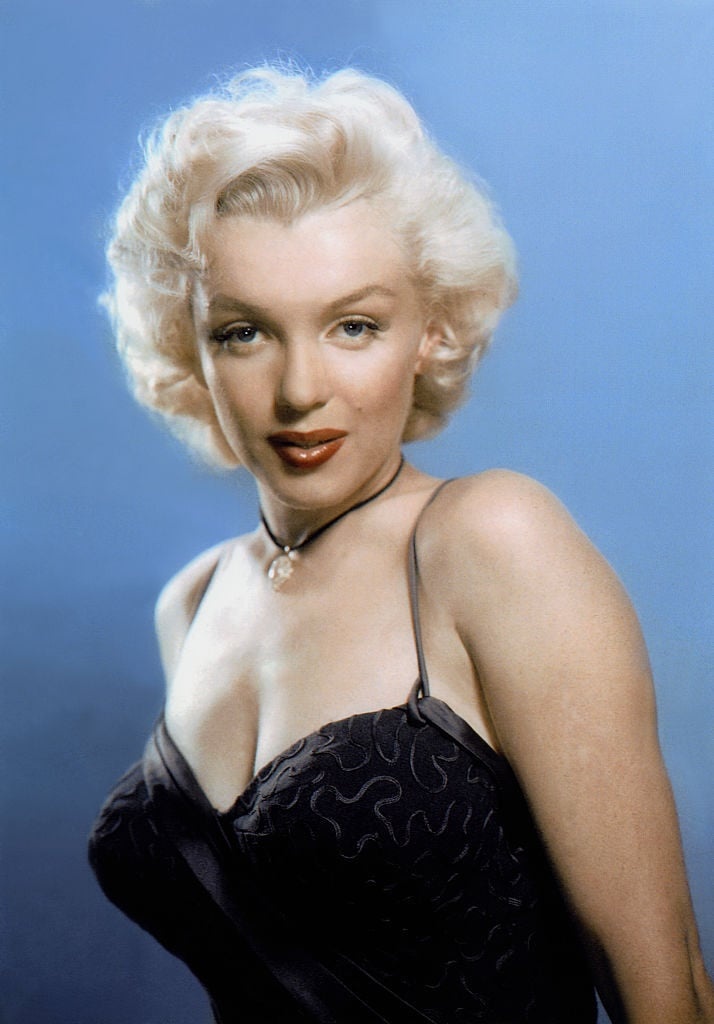
Gladys then worked as a film negative cutter in Hollywood. In 1924, she married Martin Edward Mortensen, but they soon split up. Two years later, on June 1st, 1926, Marilyn Monroe was born Norma Jeane Mortenson, not Norma Jean Baker. Her father was Charles Stanley Gifford, who had a brief affair with Gladys. When he found out Gladys was pregnant, he rejected her. Marilyn’s mother kept her father’s identity from her for years.
It Runs in the Family
Gladys had severe mental health issues. Within a week of giving birth to Marilyn, she tried to stab a friend in a delusional episode. As such, she struggled to care for an illegitimate newborn, so she placed Marilyn in foster care. The young girl spent her early childhood years with an evangelical Christian couple, Albert and Ida Bolender, in Hawthorne, Los Angeles. At first, Gladys lived with them, but when she had to find work, she moved out and visited her daughter at weekends.
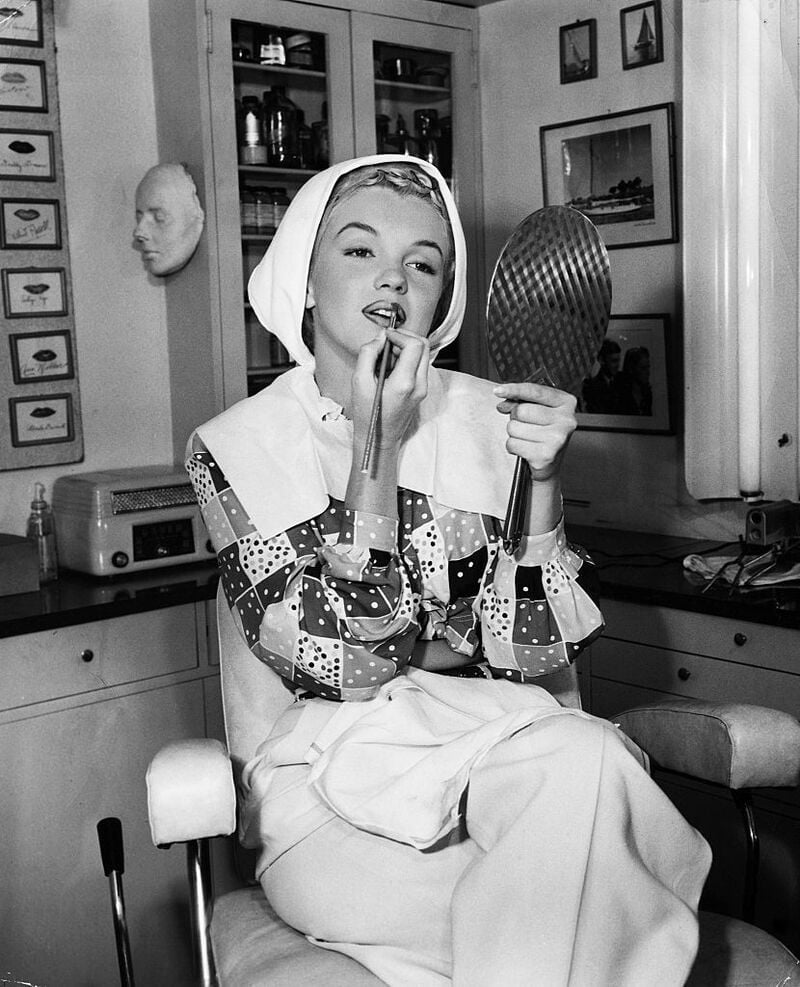
By the time Marilyn was seven years old, Gladys was back on her feet and tried her best to look after her daughter. She bought a small house in Hollywood with a loan, which they shared with actors George and Maude Atkinson and their daughter, Nellie. But lodging with the Atkinsons turned out to be the worst environment imaginable.
Daddy Dearest
When Marilyn was eight years old, Gladys showed her a photograph of her father for the first time. “Norma Jeane was enthralled by the handsome man staring from the photo with piercing eyes and a thin mustache,” wrote Charles Casillo in his 2018 book Marilyn Monroe: The Private Life of a Public Icon.
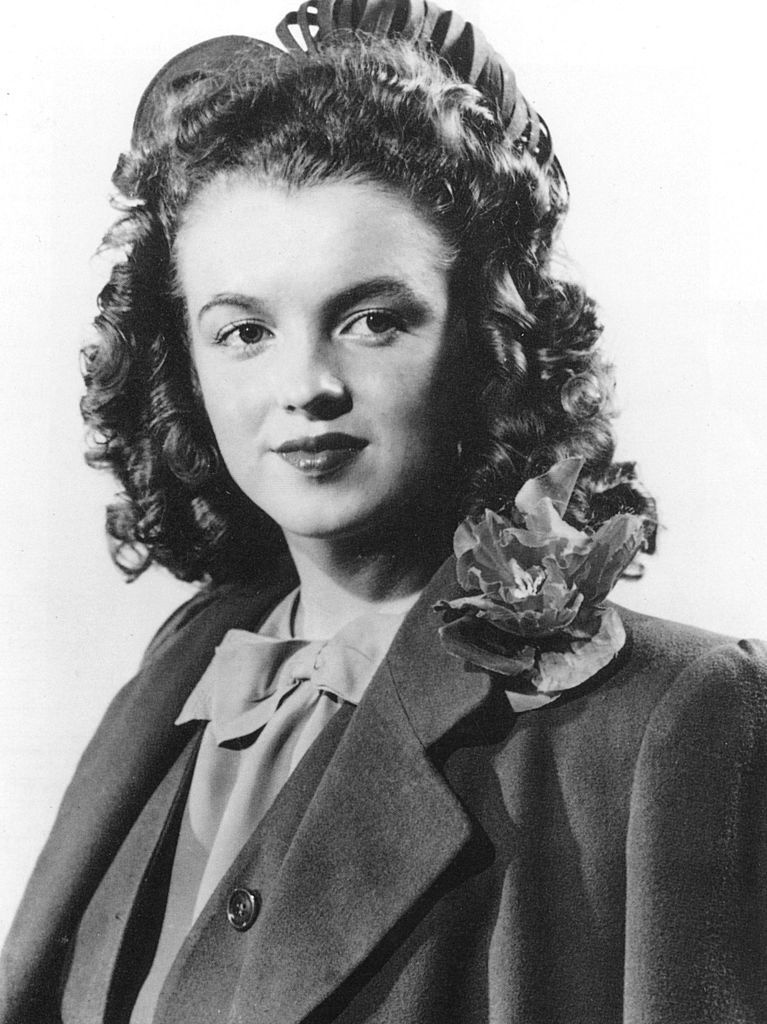
The photo became a meaningful symbol. She would spend the rest of her life desperately seeking fatherly love from almost every man she met. “Norma Jeane would spend a lifetime looking for this man in others, wanting to know him, loving him, passionately wanting him to love her back,” wrote Casillo. Around the same time, when Marilyn was aged eight, she was sexually abused for the first time in a boarding house.
Abuse
When Gladys learned her son Robert Kermit Baker died at 15 in 1933, she took her anger out on Marilyn. ‘Why did Robert have to die, not Norma Jeane?’ She lamented. More bad news came when Gladys’s grandfather hanged himself. By 1934, Gladys had lost her job and her grip on reality and was institutionalized in a psychiatric hospital, where she was diagnosed with paranoid schizophrenia.
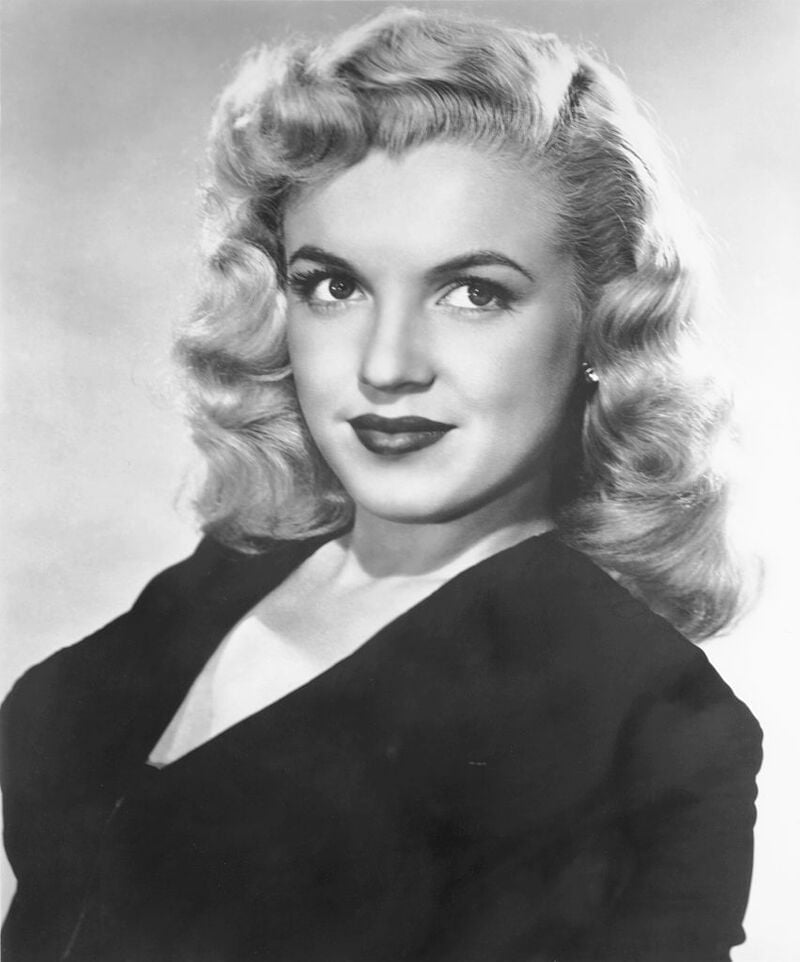
Marilyn kept living with the Atkinsons, who sexually abused her. She became withdrawn, developed a severe stutter, and her grades began to slip. Then, in 1935, she briefly stayed with Grace and her husband Erwin “Doc” Goddard––family friends who had taken over Gladys’s affairs after Marilyn became a ward of the state––and two other families. Eventually, in September ’35, Grace placed Marilyn in the Los Angeles Orphans Home.
Orphanage
The orphanage staff believed Marilyn would be happier living with a family, so, in 1936, Grace Goddard became her legal guardian but she did not take Marilyn out of the orphanage until the summer of 1937. Unfortunately, Marilyn’s second stay with the Goddards in Van Nuys lasted only a few months as Grace’s husband Doc also molested her.
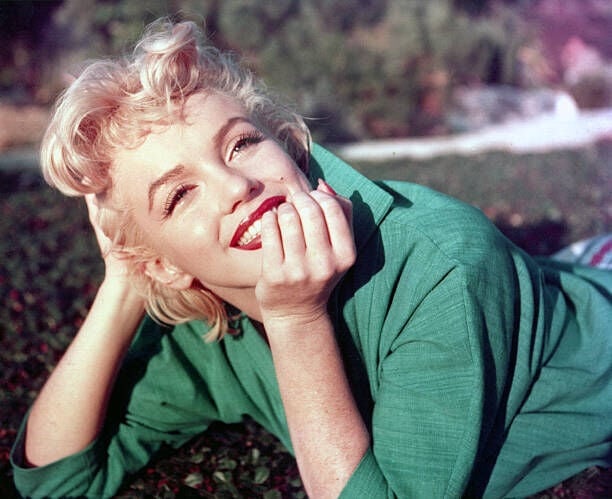
Throughout her adolescence, Marilyn was passed around foster homes like a puppet. In one house, a foster parent abused her behind a barn. In another home, she was attacked by her foster sister’s boyfriend. Luckily, she found a semi-permanent home in 1938 with Grace’s aunt, Ana Lower, in Sawtelle. But when elderly Ana got sick, Marilyn returned to the Goddards in 1941. The next year, Doc Goddard’s work relocated him to West Virginia, but Californian child protection laws prevented them from taking a foster child out of state. Marilyn faced the prospect of returning to the orphanage.
Teenage Bride
Eventually, Marilyn decided she’d had enough of being passed from pillar to post and being abused, so she decided her only way out was to drop out of Van Nuys High School to become a teenage bride and housewife. And so, on June 19th, 1942, just after her 16th birthday, she married her neighbor’s son James Dougherty so she didn’t have to go back to the orphanage.
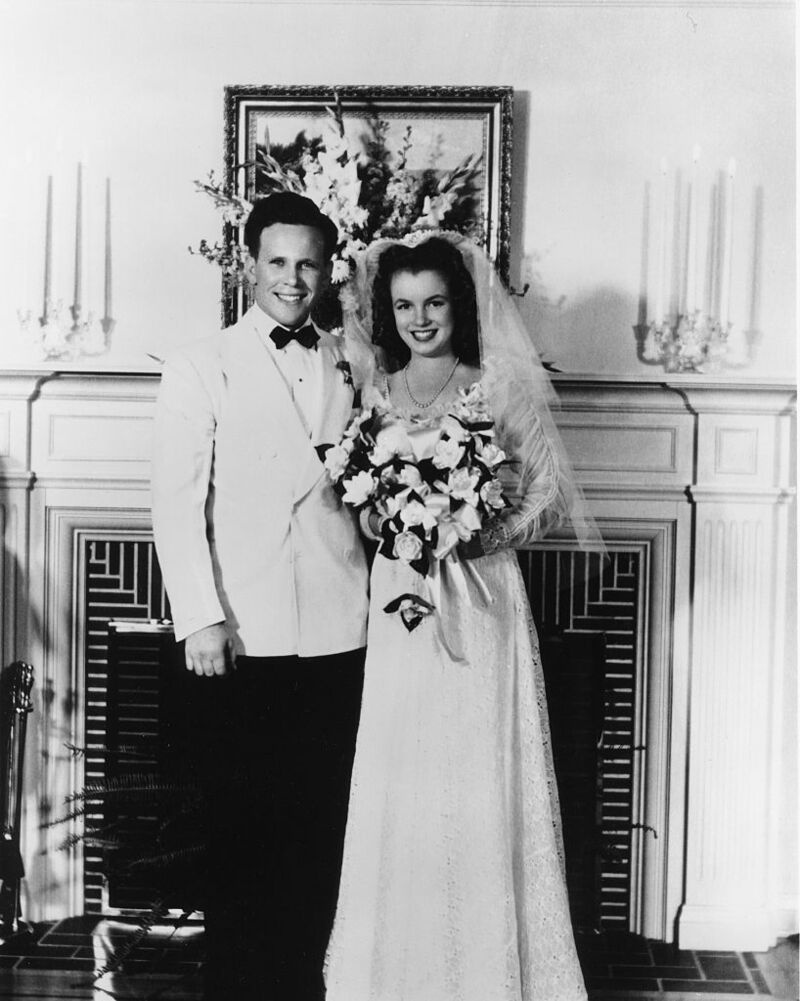
In 1943, Dougherty enlisted in the Merchant Navy and was stationed to Santa Catalina Island. Marilyn moved with him but soon found herself “dying of boredom”, so she took up weightlifting and surfing. Then, in 1944, James was shipped out to the Pacific to fight in WWII for almost two years. Monroe moved in with her in-laws and began working at the Radioplane Company, a munitions factory in Van Nuys.
Kiss, Kiss, Bang, Bang!
In 1944, the stars aligned, and a date with destiny came-a-calling. To support the war effort, the U.S. Army sent photographer David Conover to the factory to shoot morale-boosting pictures of young attractive female workers. The auburn-haired beauty immediately caught the photographer’s eye. Although none of her photographs were used, Marilyn quit the factory to model for Conover. Then, defying her overseas-deployed husband, she signed a contract with the Blue Book Model Agency in August 1945.
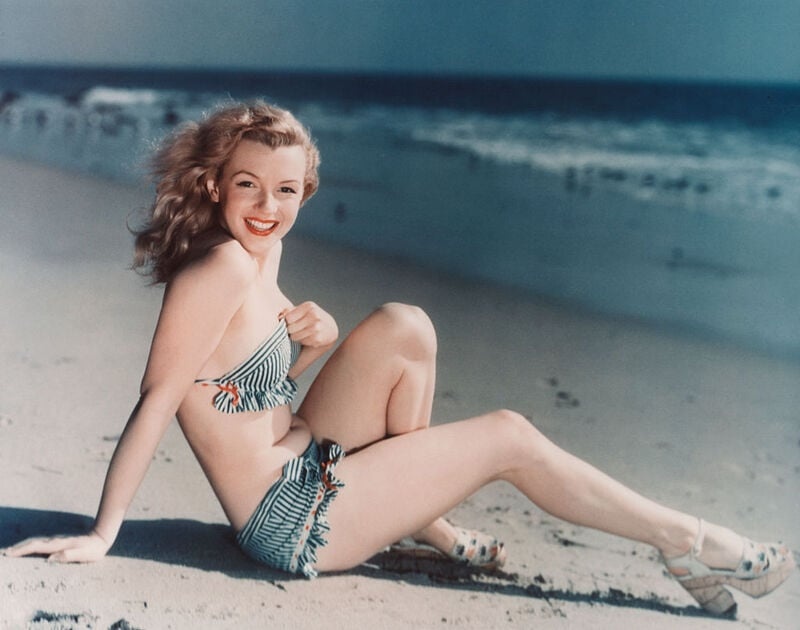
Modeling had lit a fire within Marilyn’s soul. No longer could she spend her days tolling in a factory married to a dullard, who was away at war. The only logical next step was to kick off a modeling career. Blue Book thought she was more suitable for pin-up than high fashion. Marilyn started modeling, but little did she know that her demons were about to reappear…
Pin-Up Girl
By 1946, Marilyn had modeled for Pageant, Salute, U.S. Camera, Laff, and Peek, usually using the pseudonym Jean Norman. But her new life was turned upside down when her unhinged mother showed up at her door. Gladys was released from the psychiatric ward and brought her many troubles with her. Though unemployed, Gladys dressed as a nurse and treated her daughter cruelly. Then, almost as quickly as she arrived, Gladys suddenly abandoned her daughter yet again while she swanned off to marry an already-married man in Idaho.

According to Blue Book’s owner, Emmeline Snively, Marilyn soon became one of its most ambitious, hard-working models. It was around this time that Marilyn became obsessed with her appearance. She exercised to lose more weight to make herself more employable.
Her Plastic Surgery X-Rays Were Sold For Thousands
In 2013, records and x-rays were found that prove Marilyn had gotten surgery. Later that year, those x-rays and other personal records were sold for a whopping $62,500. These included a chin implant to correct what she called a “chin deformity,” as well as a “tip rhinoplasty” on her nose. Sadly, the records also detail Monroe’s painful recovery after experiencing an ectopic pregnancy.
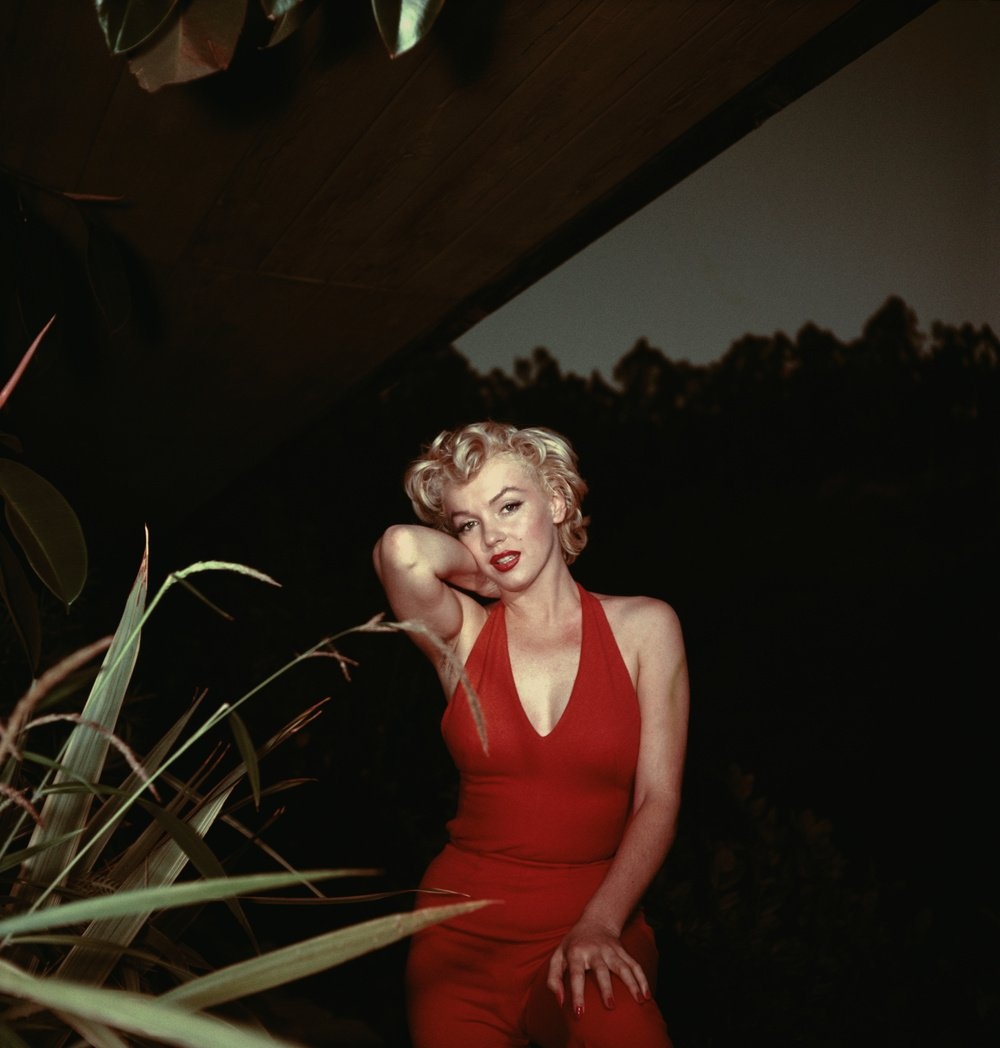
The Hollywood Auction sold Marilyn’s private medical history from 1950-1962, her 1952 Redbook Award for Best Young Box Office Personality, and photos of her visiting American soldiers during the Korean War. It’s clear that Marilyn continues to be such an alluring figure decades after her death—the most private information about her life is heavily sought after. Yet, we wonder, how would Marilyn herself feel about this type of attention?
Hollywood Calling
In June 1946, Emmeline Snively introduced Marilyn to an acting agency. After an unsuccessful interview at Paramount, she screen-tested at 20th Century-Fox and won a six-month contract. Legend says she only won the contract because Darryl F. Zanuck wanted to stop rival studio RKO Pictures from signing her!
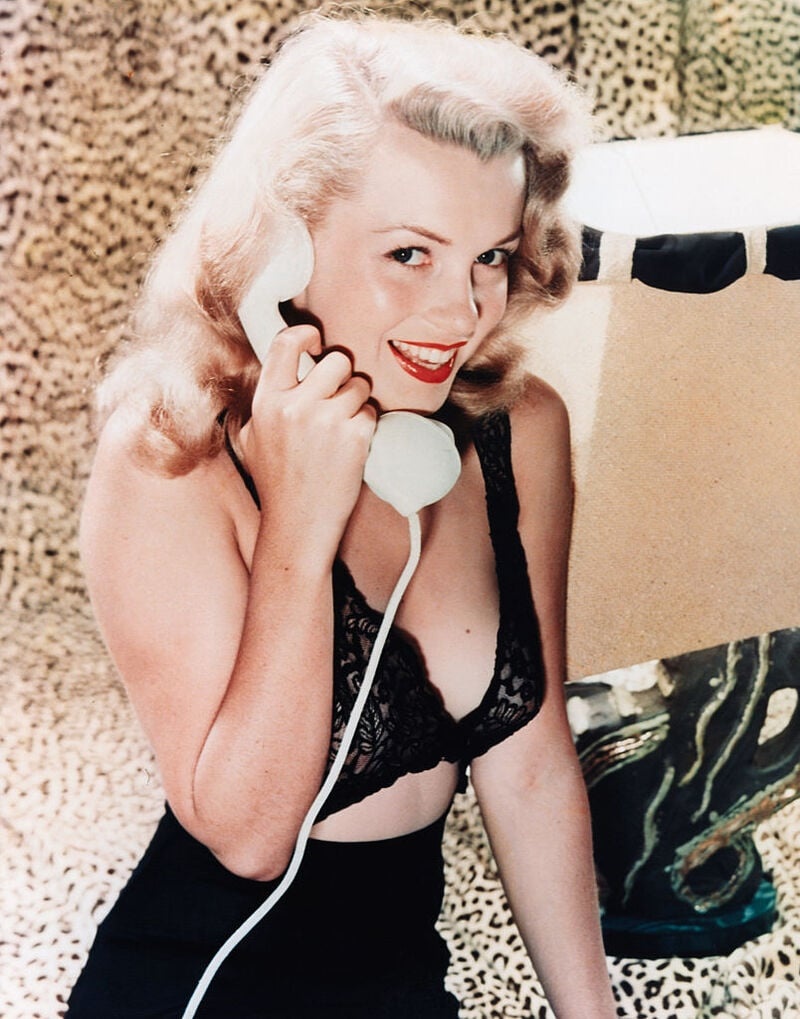
In August 1946, she and Fox exec Ben Lyon selected the stage name “Marilyn Monroe”. Lyon chose the first name as it reminded him of Broadway star Marilyn Miller, while the surname was Monroe’s mother’s maiden name. The following month, she divorced James and Marilyn Monroe was finally free! She spent her first six months on Fox studio’s lot, learning to act, sing, dance, and observing the film-making process.
She Had An Affair
The tuition worked, and she soon won her first minor parts. Fox also enrolled her in the Actors’ Laboratory Theatre. Talking about her time in the Laboratory, she said: “it was my first taste of what real acting in a real drama could be, and I was hooked”. Despite boundless enthusiasm, her tutors believed her to be too shy and insecure to have a future in acting, so Fox canceled her contract.
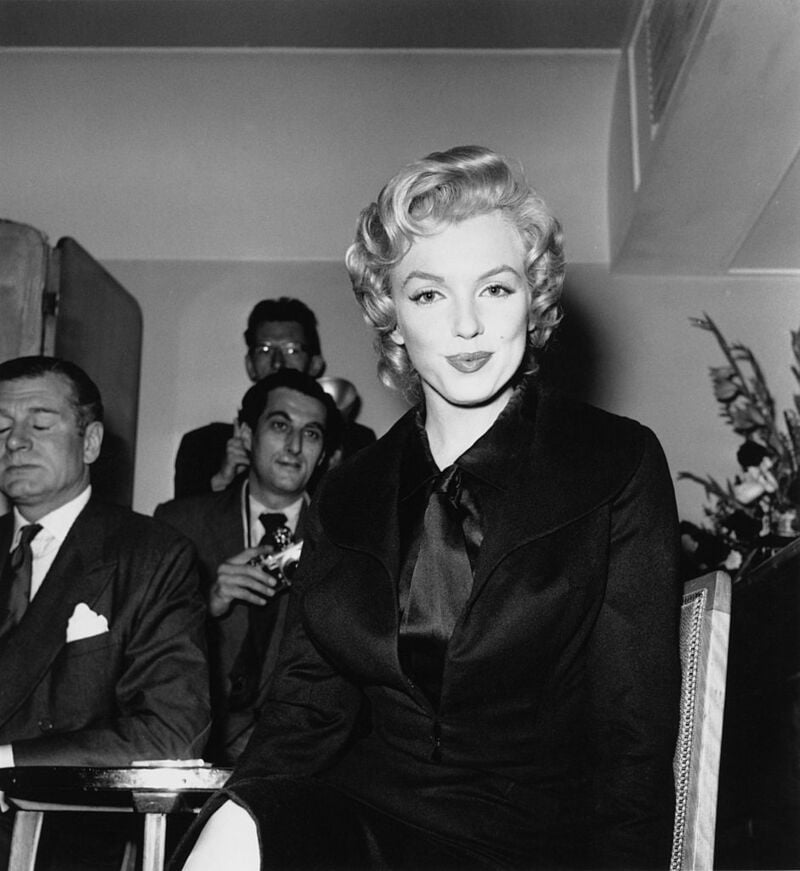
Finally, in 1948, Columbia took a chance on Marilyn, and she began working with the studio’s head drama coach, Natasha Lytess. According to Charlie Chaplin’s autobiography, when Marilyn wasn’t filming bit parts, she dated his son Charlie Junior. Unfortunately, Chaplin Snr. claimed that Marilyn’s and his son’s relationship ended in tatters when Charlie Junior caught Marilyn in bed with his own brother, Sydney Chaplin!
A Secret Daughter
In 2019, a broke 72-year-old woman made a surprising deathbed confession, saying, “I am Marilyn Monroe’s secret daughter”. Nancy Maniscalco Miracle claims Monroe had her when she was 20 years old following a secret relationship with a New York lawyer who has since passed away. Reaching the end of her life, Nancy wanted to share her story. Miracle explained, “My mother was very ambitious and thought that having a baby out of wedlock would ruin her career.”
ADVERTISEMENT
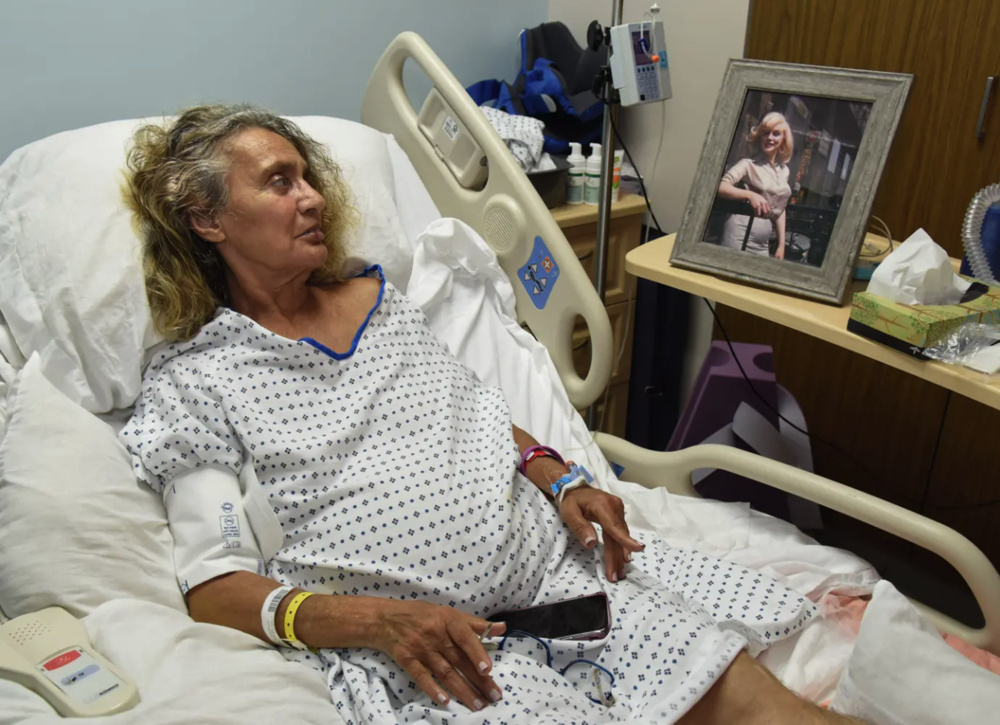
Miracle revealed that Marilyn and her boyfriend, Vincent Bruno, gave her to a wealthy New York family who raised her as if she were their own child. “Officially, I didn’t even exist,” Miracle said from her bed. It was only after Marilyn and Bruno passed away, that Miracle’s “adoptive” mother told her the truth. Miracle explained, “I don’t want anything from my real mother,” Miracle claimed.
The Casting Couch
As an aspiring actress, Marilyn was at the mercy of sexual predators, including Joe Schenck, chairman of 20th Century Fox. The 69-year-old awarded her a contract on the condition she “serviced” him whenever he called.
ADVERTISEMENT
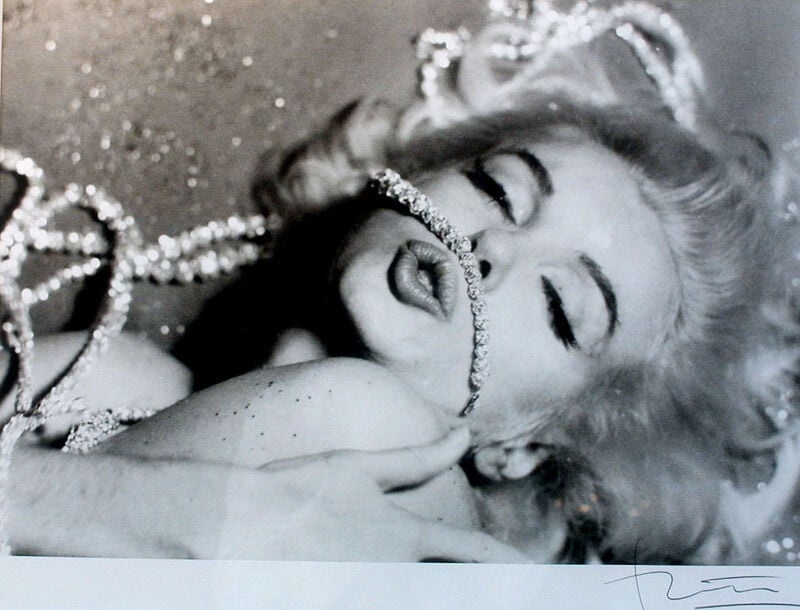
After Monroe’s six-month contract was up, she hoped her days on the casting couch would end. But to renew her contract, another studio executive, Harry Cohn, offered her the same dirty deal. When Marilyn refused, the studio promptly declined to give her another six-month contract.
ADVERTISEMENT
ADVERTISEMENT
Beauty and Difficulty
Marilyn Monroe finally broke into Hollywood when she appeared in a hit musical romance, Ladies of the Chorus (1948), opposite actress Adele Jergens. Years later, Adele’s boyfriend, Milton Berle, claimed that he and Monroe had a brief affair while making the film.
ADVERTISEMENT
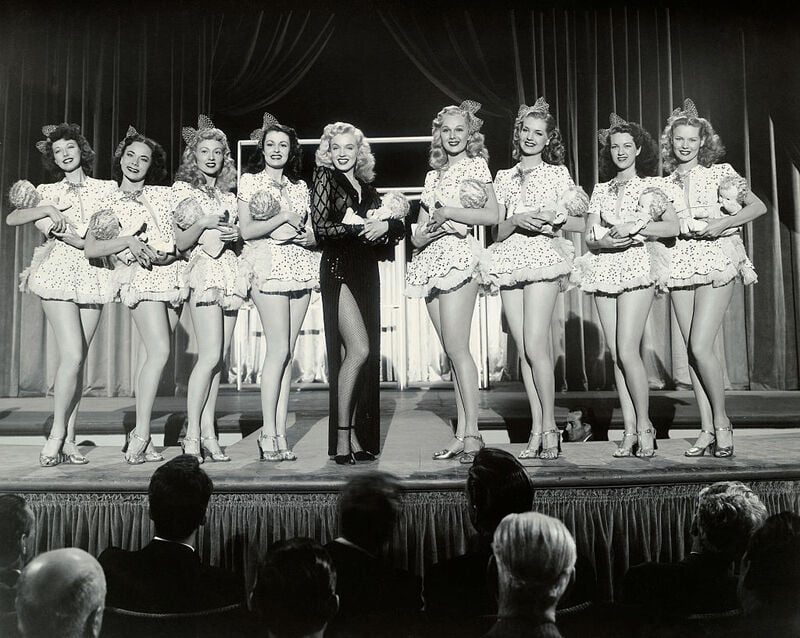
Despite her stunning beauty, Marilyn’s journey to the top was plagued with difficulty. In 1949, after years of modeling and minor movie roles, she was broke. Desperate for work and money, Marilyn posed in a series of risqué nudes for John Baumgarth calendars using the name Mona Monroe.
Plastic Surgery
A couple of years earlier, Orson Welles shockingly made his wife, Rita Hayworth, cut her long auburn hair short and made her dye it blonde for The Lady from Shanghai (1947). So when Marilyn arrived at Columbia in 1948, her hair was bleached platinum blonde. Marilyn often mentioned men holding her down to attack her at Hollywood soirees, and Orson Welles recalled one party where “Marilyn was surrounded by men, and one reached out and tore off her top, revealing her breasts … Marilyn laughed with the others at this indignity. Laughter hid her fury.”
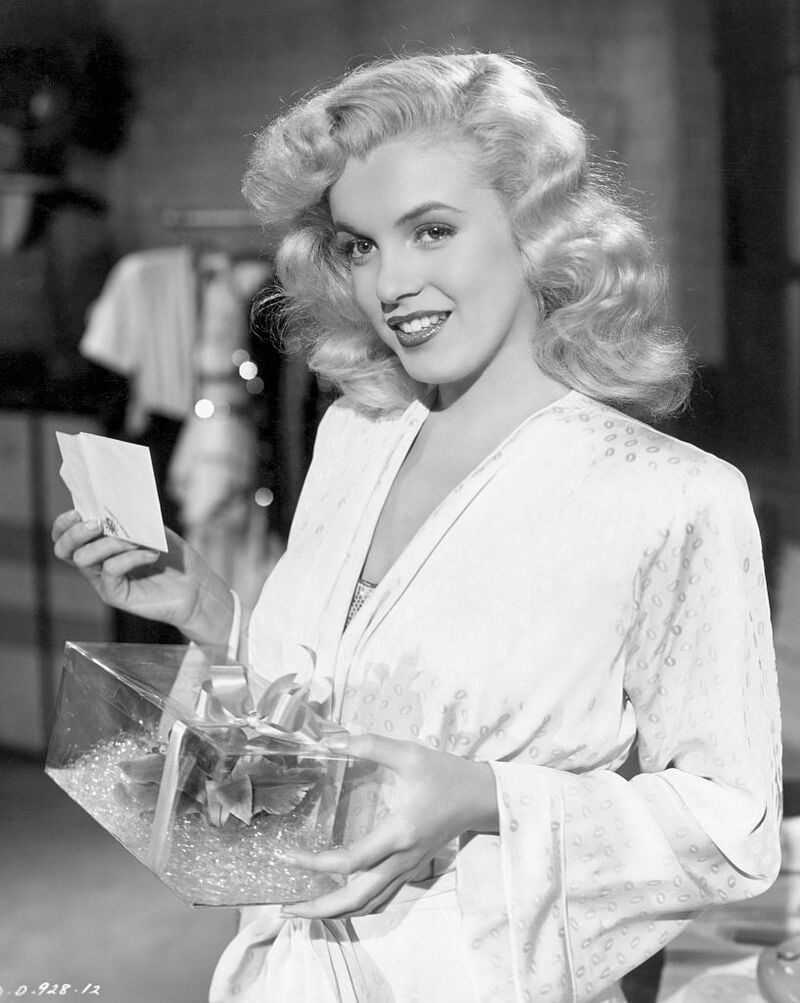
In 1950, Marilyn had her front teeth fixed to make her appearance less goofy. She also had two painful plastic surgeries: A tip rhinoplasty to reshape the end of her nose and a chin implant. She also began to whiten her already fair skin with hormone cream, but this caused light blonde hairs to sprout all over her face. Even while sporting a fine, feathery beard, she refused to stop her skin-bleaching routine.
Breakthrough
One of Marilyn’s earliest film roles was playing Miss Caswell in All About Eve (1950), a role originally offered to Zsa Zsa Gabor. But her nerves and lack of acting experience meant she’d didn’t remember her lines and needed multiple takes just to get through a single scene. In addition, Monroe was horribly insecure and always felt she was doing a terrible job. Yep, even Marilyn Monroe had imposter syndrome!

While filming All About Eve, Monroe’s beauty, charm and vulnerability made her irresistible to her co-star, George Sanders. So much so that his wife, Zsa Zsa Gabor, kept showing up on set to make sure nothing was going on between the two. The same year, Marilyn appeared in John Huston’s film noir The Asphalt Jungle (1950).
She Heard Voices
Marilyn appeared in 16 movies in her first four years in Hollywood and all this hard work began to take a toll. Yet it seems to have taken a mental toll on her, as she confided in her acting coach that she was hearing voices. This was one of the first symptoms of the mental instability that would haunt Monroe for the rest of her life. In 1950, Monroe underwent more trauma.

For the last two years, she’d been dating her agent, Johnny Hyde. He suddenly died of a heart attack aged 55. Monroe had been his protégé, and she wrote that she lost “her greatest friend.” Devastated, she wept for days and even howled his name at the funeral. After Hyde’s death, Marilyn’s acting coach found her unconscious on her bed with thirty sleeping pills in her mouth. She hadn’t swallowed enough to kill herself, but this wouldn’t be Marilyn’s only suicide attempt.
Haunted by the Past
Amidst all this heartbreak, Marilyn worked hard filming her breakout role in Fritz Lang’s Clash By Night (1951). Appearing opposite Barbara Stanwyck, superstardom beckoned. Until, that is, journalists uncovered Monroe’s nude photos from 1949. After the leak, superstardom did arrive, but not for her acting talents.
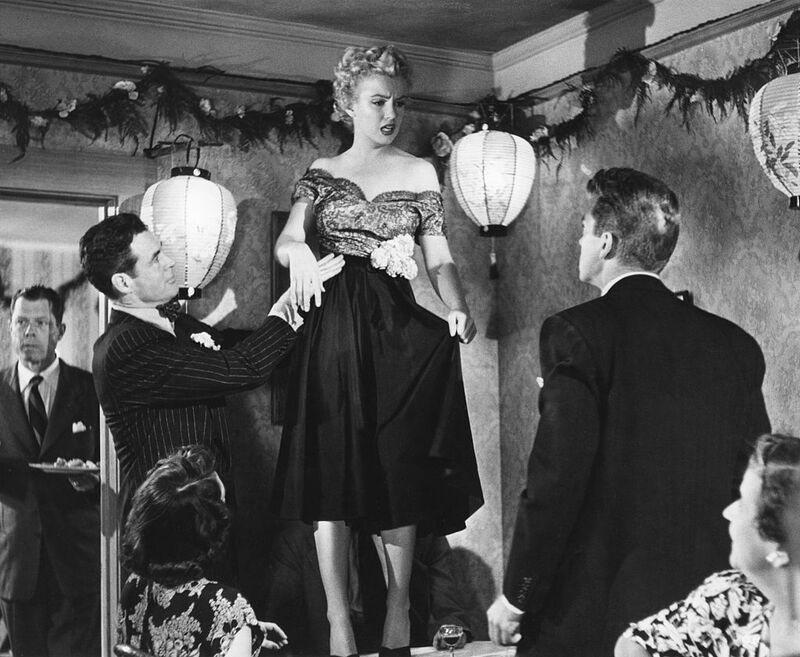
After the photos leaked, she became an overnight sensation. While the scandal would have ruined anyone else’s career, this screen siren took her new seductress image in her stride. When reporters asked, “Marilyn, is it true that you had nothing on?” she quipped, “No, that’s not true. I had the radio on.” Her nude photos were later used as the centerfold and on the cover of the first issue of Playboy in 1953.
The Ultimate Rejection
In 1953, Marilyn finally decided to reach out to the man she believed to be her biological father: Charles Stanley Gifford. After searching for him for months, she eventually tracked him down and explained on the phone that she was his daughter with Gladys. Gifford callously shut her down by stating, “Look, I’m married, and I have a family. I don’t have anything to say to you. Call my lawyer.”
ADVERTISEMENT
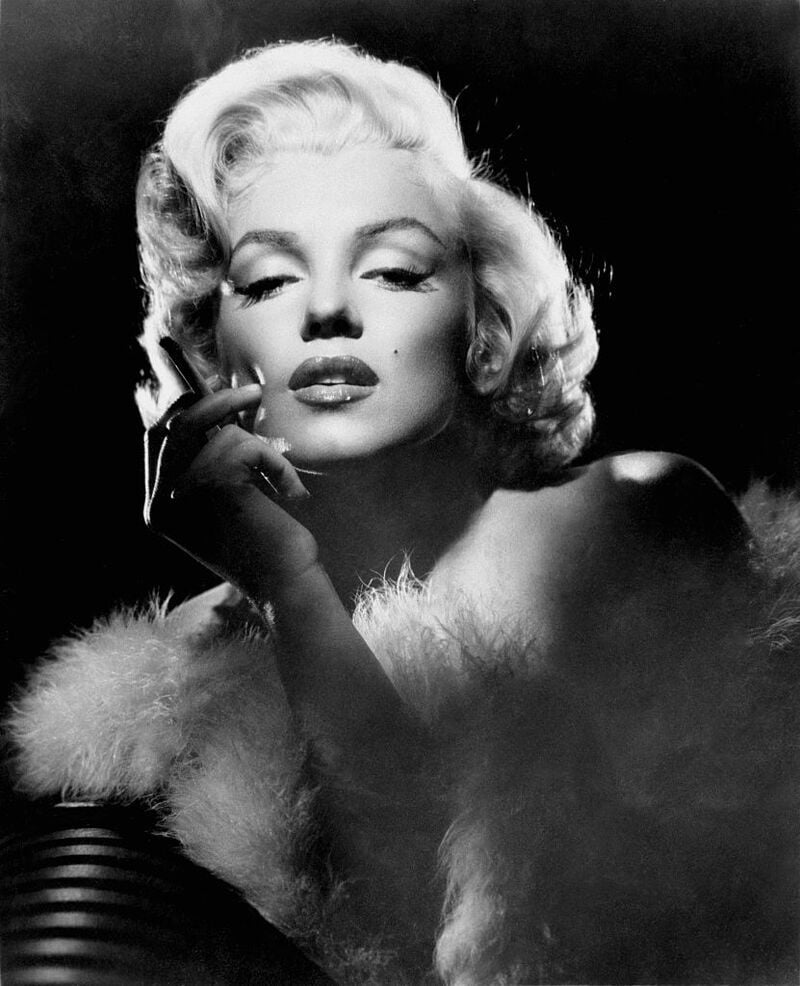
Her father’s rejection crushed her and led her to dark places. Marilyn’s friend, Casillo, wrote, “Marilyn confessed that she longed to ‘put on a black wig, pick up her father in a bar and make love to him.’ Afterward, she would ask, ‘How do you feel now that you have a daughter that you’ve made love to?'” Fantasy aside, this rejection became the catalyst for a string of disturbing and disastrous encounters with men.
She Was In Constant Pain
Her career may have been on the up, but her personal life was heading south. First, terrible, monthly menstrual pain warranted a clause in her contract allowing her to be absent from work during her period. Then, in 1952, after years of suffering from incurable endometriosis, she had to undergo surgery.
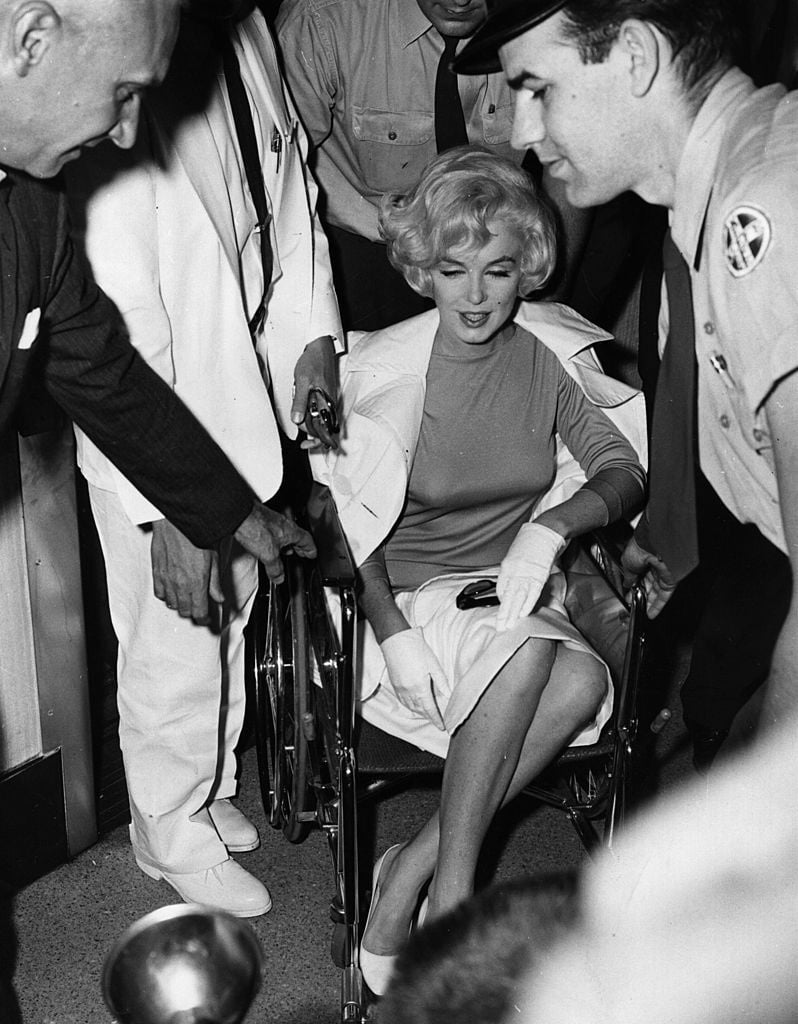
Marilyn was always desperate to have children, so she taped a note to her stomach in a last-ditch plea to her surgeons, begging them not to remove her ovaries during the procedure.
She Hated Playing Bimbos
In 1953, she appeared in three hit movies: Niagara, Gentlemen Prefer Blondes, and How to Marry a Millionaire. However, she could have done with marrying a millionaire because she earned just 10% of her co-star Jane Russell’s salary on Gentlemen Prefer Blondes.
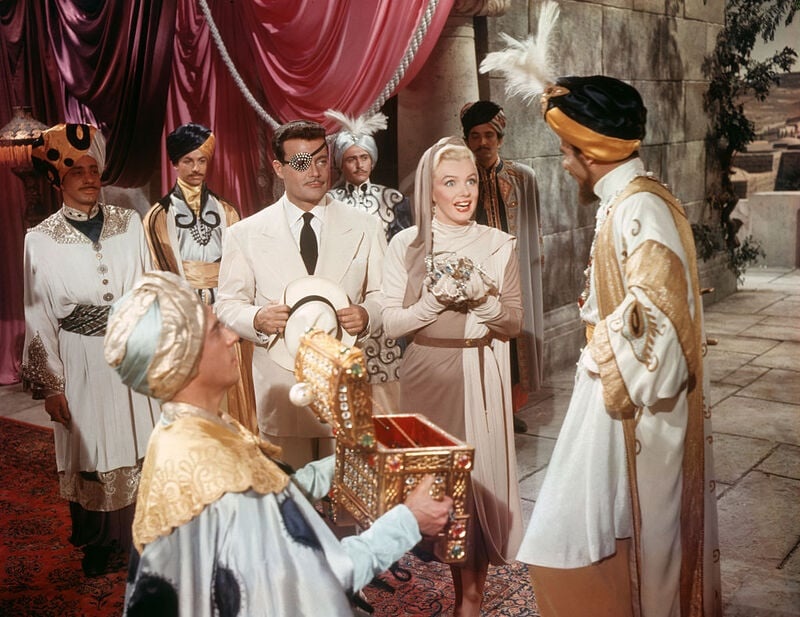
Studios wanted Marilyn to be their new blonde bombshell, which back then meant “dumb blonde.” She hated being typecasted as a ditz, but Marilyn knew that she’d have to play along to become a star. Unfortunately, around this time, she gained a reputation for being difficult to work with. She was still incredibly insecure and needed her overbearing acting coach with her all the time. Marilyn would demand to re-shoot the scene up to forty times if a scene didn’t win the coach’s seal of approval.
Rocky Relationships
Amidst all this turmoil, Marilyn was busy in the romance department too. In her early Hollywood days, she dated On the Waterfront (1954) director Elia Kazan, Rebel Without a Cause (1955) director, Nicholas Ray and actors Yul Brynner and Peter Lawford.
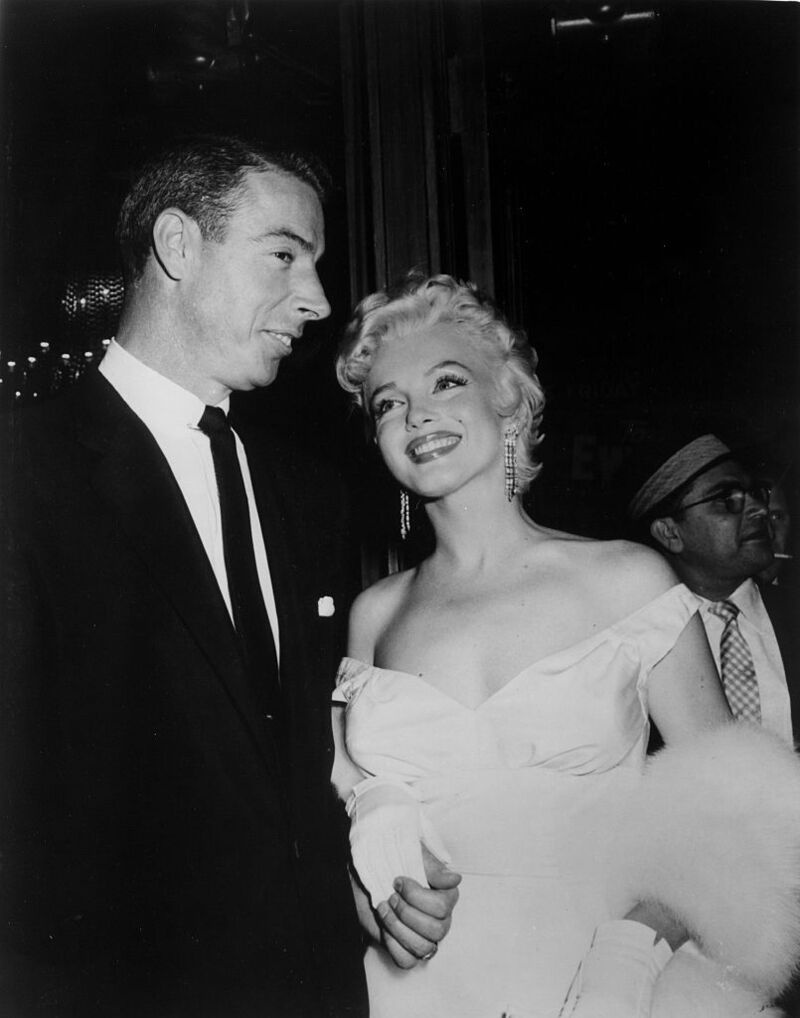
In 1952, her agent set her up with retired New York Yankees baseball player Joe DiMaggio. His ex-wife, actress Dorothy Arnold filed for divorce in 1943, citing “cruel indifference”, but Marilyn fell for him. They eloped to San Francisco in January 1954. Marilyn told a friend: “Except for Joe, I’ve sucked my last c**k.” They honeymooned in Japan, and Marilyn performed for US troops in Korea. When she arrived home, she won a new Fox contract, a $100,000 bonus, and a starring role in The Seven Year Itch (1955). Wedded life was bliss until Marilyn found out.
DiMaggio was a Controlling Monster
Joe loved to stay at home, drinking, smoking, and watching TV. He wanted a traditional, stay-at-home housewife. Conversely, Marilyn was always on a self-improvement quest: psychotherapy, devouring books, and art. Joe hated her highly sexualized roles, so he laid down rules to approve her future roles. Furthermore, she was never to appear semi-dressed and must break out of her “dumb blonde” typecasting. Within weeks of tying the knot, he felt he was losing control, so he’d give her the silent treatment for days.
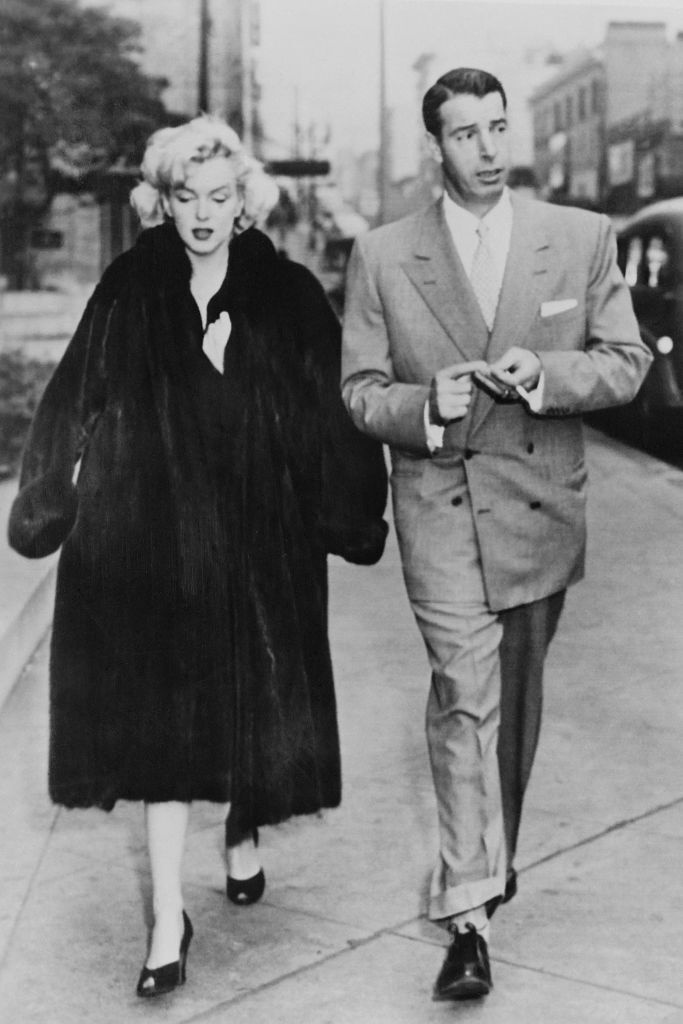
While filming her era-defining The Seven Year Itch scene, DiMaggio lost the plot. A crowd of wolf-whistling onlookers assembled and DiMaggio demanded: “What the hell is going on here?” After the shoot, they returned to their hotel room and got into a “yelling battle”. When Marilyn arrived on set the next day, her arms were covered in bruises. According to Joe DiMaggio Jnr, it wasn’t the only time his father beat Marilyn.
She Only Wanted One Thing
Marilyn adored children and animals; while the crew took lunch on the set of River of No Return (1954), she’d cuddle her co-star, a raccoon named Bandit. The only thing she wanted was a child, and she was trying to conceive a baby with her husband. Unfortunately, it wasn’t to be, as Monroe announced their divorce less than a month later.
ADVERTISEMENT
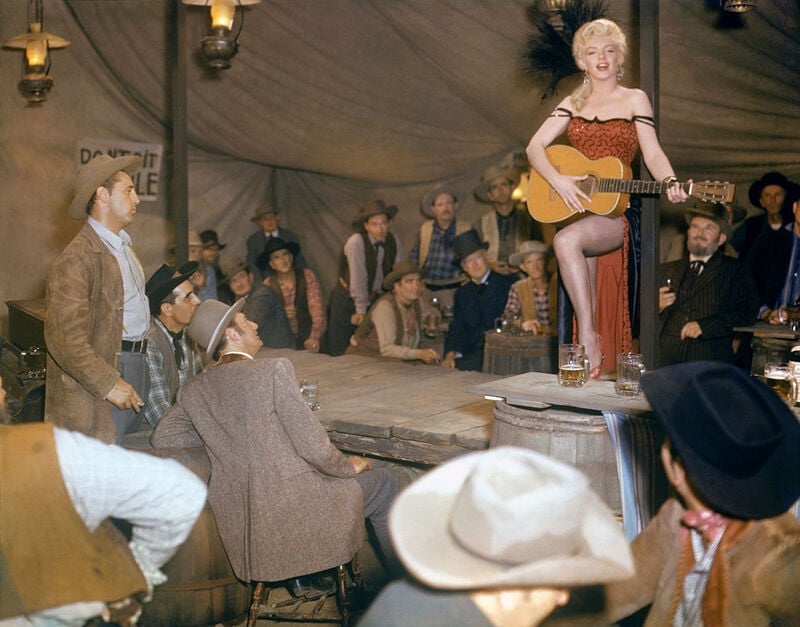
Married to a controlling man, Marilyn began drinking heavily and taking sedatives. She had an affair with her voice coach Hal Schaefer (pictured). When Joe discovered her infidelity, he called Schaefer who says he heard Marilyn screaming in the background. “Don’t come here!” she said. “He’ll kill you!” In the fall of 1954, Marilyn called time on their sham of a marriage after just nine months, citing “mental cruelty.”
Joe Stalked Her
Joe DiMaggio never wanted to split, but after the divorce, he stalked Marilyn. He’d wear a fake beard and wait in the lobby of her new home at Waldorf Astoria on Park Avenue. He had her phones tapped and would show up, hoping to catch her with other men. Beside himself, Joe turned to the one man who would understand his predicament: Frank Sinatra. Old Blue Eyes had hired a private investigator to trail his great obsession and soon-to-be-ex, Ava Gardner.
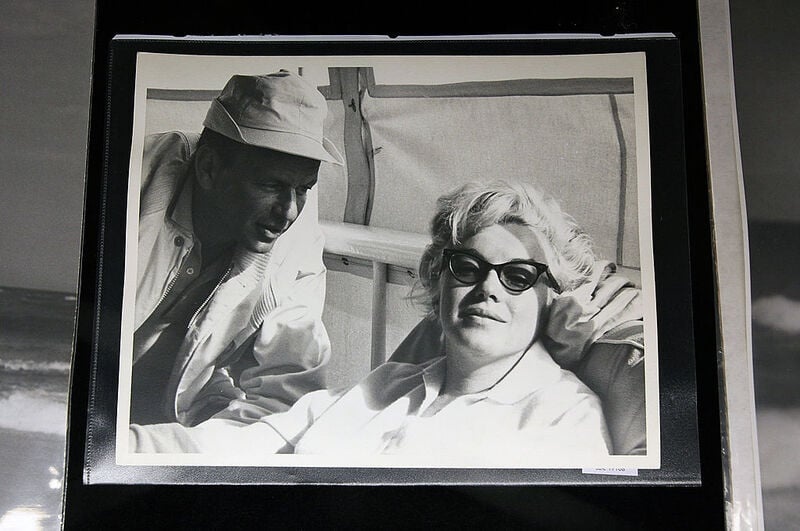
One drunken night, DiMaggio, Sinatra, and five henchmen drove to West Hollywood to dish out some mafia-style revenge to Hal Schaefer. Sinatra was alarmed by how enraged DiMaggio was but couldn’t calm him. Then, at 11:30 p.m., 50-year-old secretary Florence Katz awoke to find “her door broken down and Joe DiMaggio and Frank Sinatra hovering over her, ready to pounce.” She screamed, and the cops came, but they kept the stars out of their report. Sinatra paid Katz $7,500 hush money, but Confidential broke the “Wrong Door Raid” story. For the rest of his days, DiMaggio claimed he wasn’t there.
Miller Time!
Marilyn Monroe rebounded by getting it on with Hollywood’s hottest young actor, Marlon Brando, and playwright Arthur Miller. Her affair with Miller became more serious in October 1955, when her divorce was finalized, and Miller separated from his wife. The studio urged her to end the affair, as Miller was being investigated by the FBI and House of Un-American Activities Committee for allegations of communism. Marilyn refused, so the FBI opened a file on her!
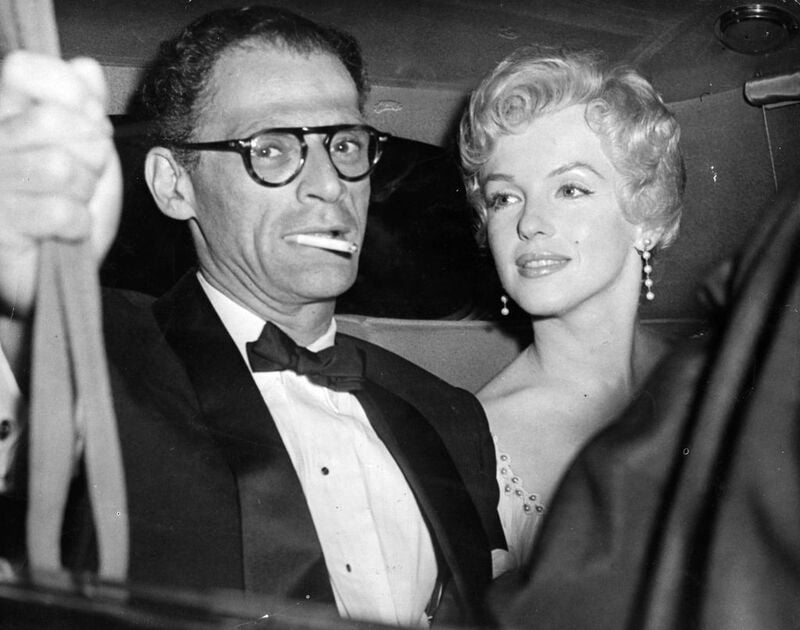
In 1956, Marilyn married Arthur Miller in New York and converted to Judaism. Variety’s headline was: “Egghead Weds Hourglass”, but the most unlikely marriage since the Owl and the Pussycat wasn’t to last.
Curiosity Killed the Cat
The same year they married, Marilyn legally changed her name from Norma Jeane to Marilyn Monroe. When a fan asked her for an autograph, Marilyn had to ask how to spell her own name. This probably didn’t go down too well with her literary husband. Nor did her sexual history.

Arthur Miller quickly regretted marrying the most beautiful, wanted woman in the world. He wrote unspeakably cruel things about her in his journal; she was disappointing, clingy, unpredictable, embarrassing… and he wanted to hurt her. Unfortunately, Marilyn found her new husband’s diary, gave in to her curiosity, and read his thoughts on their marriage. Needless to say, she was heartbroken.
Marilyn Was Falling Apart
After the success of Bus Stop, Marilyn made The Prince and the Showgirl (both 1956). Stressed out on all manner of pills, her weight fluctuated so wildly; the designer had to create her costumes in multiple sizes. Marilyn fell out with her co-star and director, Sir Laurence Olivier. The English thespian hated her constant lateness and forgetting her lines. After years of trying to shed her bimbo image, Olivier yelled at her, “Just be sexy!” In three words, he’d found her Achilles heel.
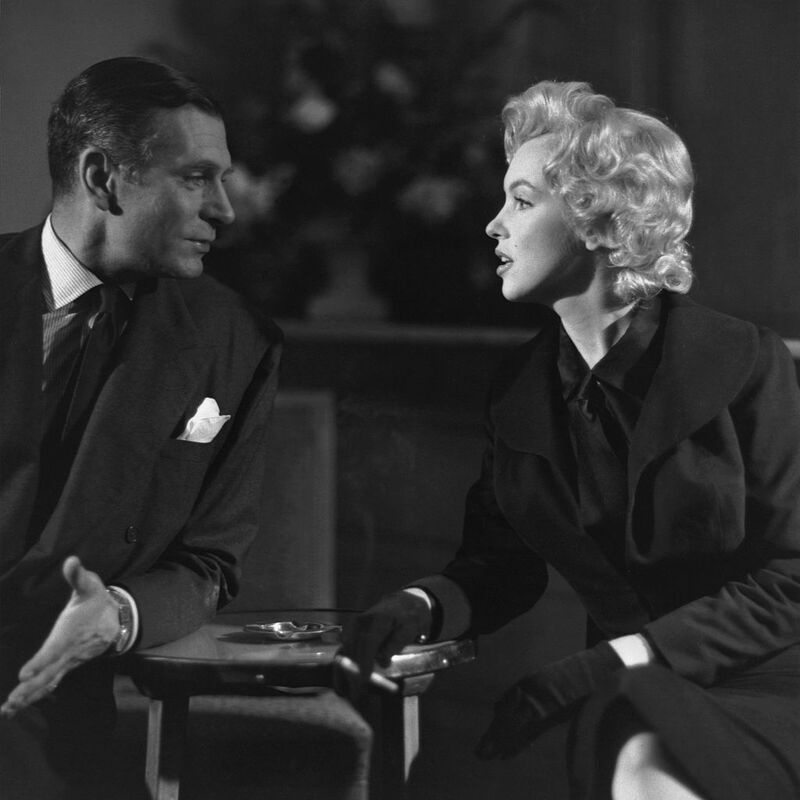
She and Miller conceived three times in 1956, 1957, and 1958. Tragically, Marilyn had two miscarriages and one ectopic pregnancy. After her third failed pregnancy, she stopped trying for a baby. For a woman who had always wanted children, the loss was devastating.
The Crew Hated Her
In 1958, she filmed perhaps her most acclaimed role in Some Like It Hot. To get a grip on her fragile emotional state and insomnia, she took a swathe of medications: It took her 60 takes to deliver one line: “It’s me, Sugar.” Marilyn’s life spiraled out of control, and she often refused to come out of her or dissolved into erratic outbursts. Her tardiness cost the production half a million dollars in over-runs.
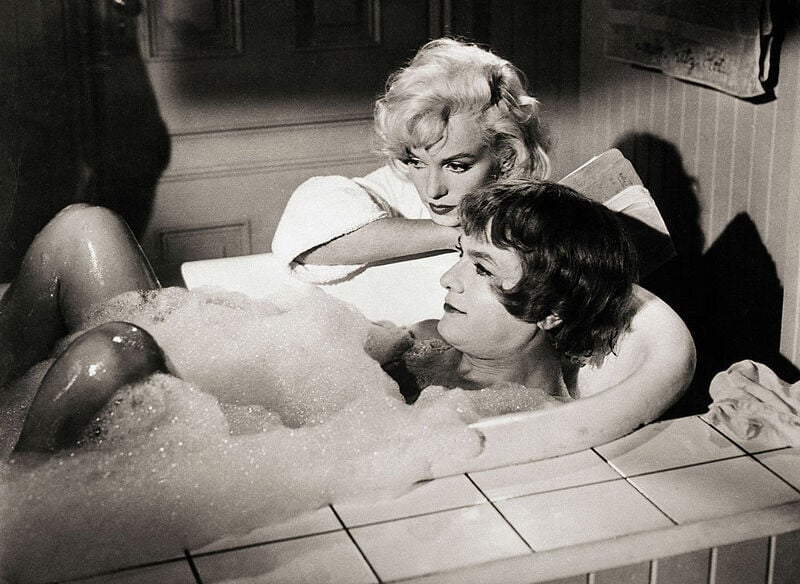
The cast and crew hated her; when Tony Curtis had to kiss her, he stated he’d “rather be kissing Hitler,” though he later claimed the two were having an affair. Marilyn was so despised, she wasn’t invited to the wrap party, and Billy Wilder started dissing her in interviews: “Anyone can remember lines, but it takes a real artist to come on the set and not know her lines and yet give the performance she did!” So, to wreak her revenge, Marilyn called Wilder’s home and asked his wife to deliver him a message: Billy Wilder could “go f*** himself.”
Outcast
Monroe was all lined up to play Holly Golightly in Breakfast at Tiffany’s (1961)—but because of her behavior on Some Like it Hot, the studio refused to hire her. So, her next movie was––somewhat ironically––called Let’s Make Love (1959).
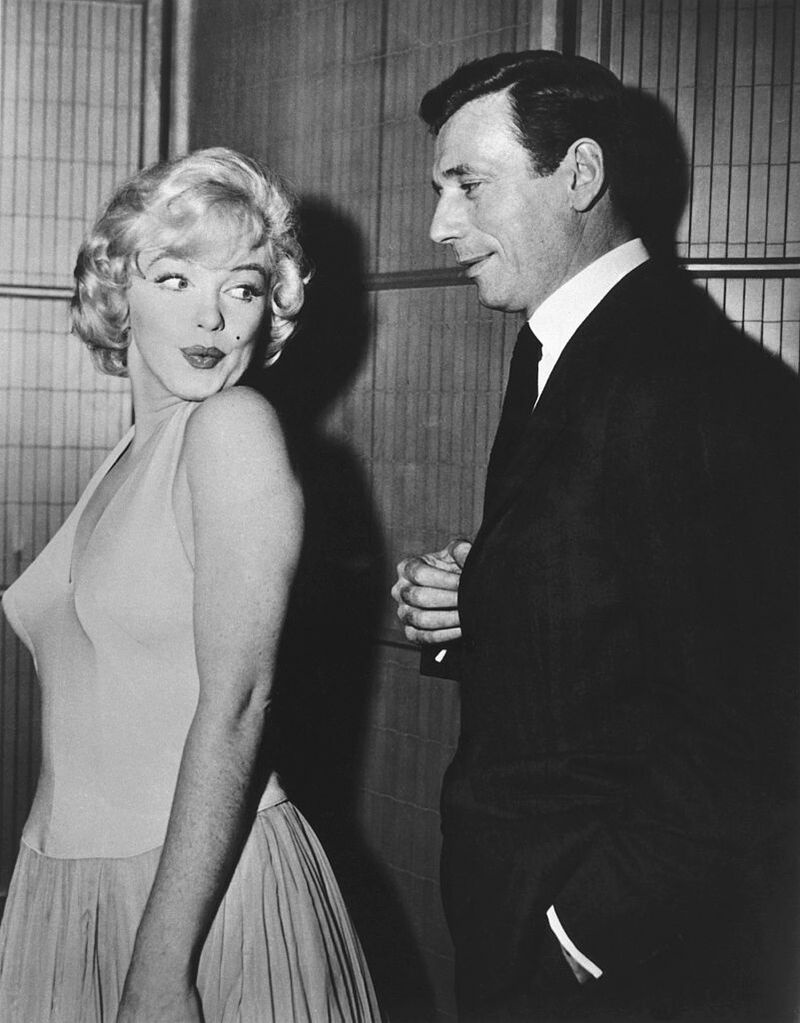
Her marriage to Arthur Miller was on its last legs. His cruel behavior made her feel alone, unloved and ashamed, so she embarked on an affair with her married co-star Yves Montand and fell pregnant with his baby. Sadly, like all her previous attempts, this pregnancy did not go full term and all this took its toll. Her next movie––The Misfits (1961)––was a complete and utter disaster. The neo-western’s three leads, Monroe, Clark Gable, and Montgomery Clift, would all be dead within years of its release.
Misfit
It’s no surprise The Misfits was a disaster. Director John Huston was an alcoholic who often showed up to work three sheets to the wind. Marilyn Monroe and Montgomery Clift both had crippling mental health issues and needed medication just to get them through the day.
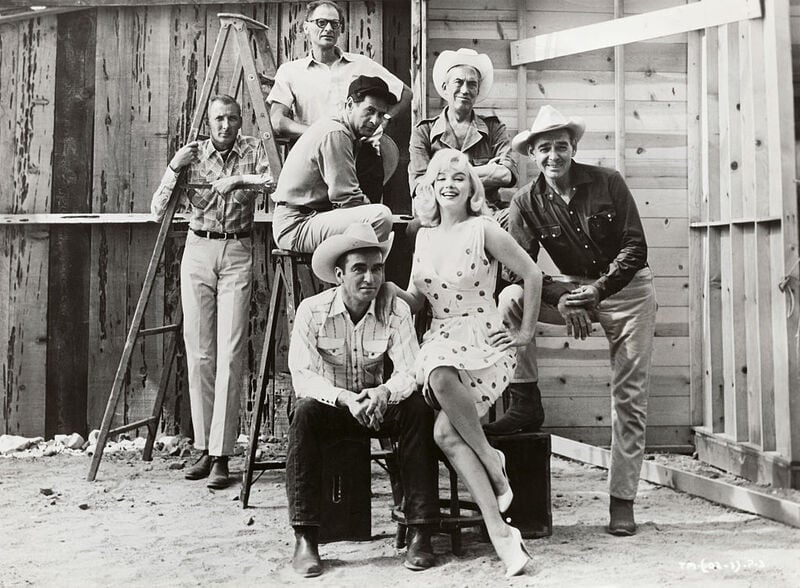
The film’s writer also happened to be Arthur Miller—meaning that the deeply miserable couple had to spend every day on set together. The plot sees a wounded young woman (Monroe) who falls in love with a much older man. Miller wrote The Misfits to give Marilyn a proper acting role in the hope they could reconcile. Instead, the experience ended their relationship forever. Miller had an affair with set photographer Inge Morath and cruelly exploited his wife’s insecurities by purposefully giving her last-minute script changes.
Terrible Pain
In terrible pain from gallstones and addiction to barbiturates, filming was halted while Monroe spent a week in a hospital detox. Yet, despite her many problems, she gave the performance of her lifetime. Director John Huston stated that when Monroe was performing, she “was not pretending to [have] an emotion. It was the real thing. She would go deep down within herself and find it and bring it up into consciousness.”
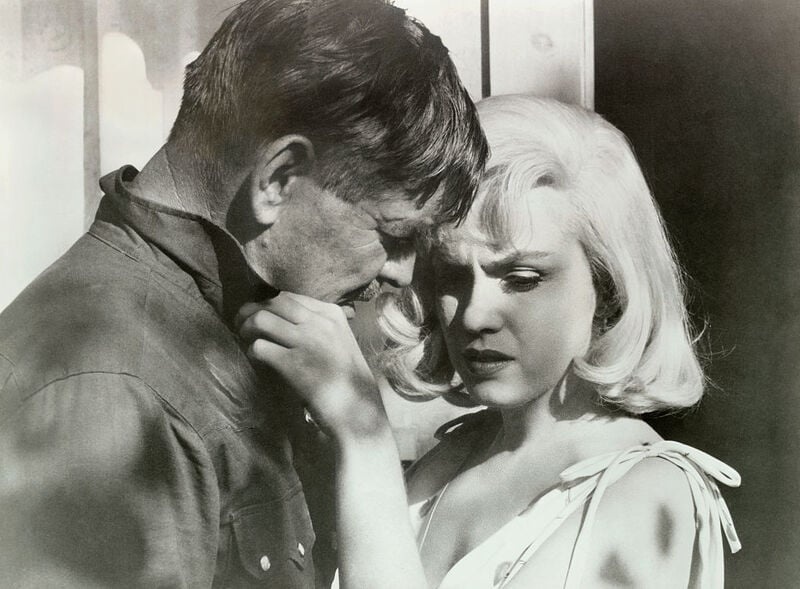
Already deeply vulnerable, filming The Misfits pushed Marilyn over the edge and into despair. During production, she told her psychiatrist she was hearing voices again. To combat her ever-deteriorating mental state, she took three times the maximum dosage of sleeping pill Nembutal. The results were catastrophic.
Father Figure
One good thing did come out of filming The Misfits, however short-lived. Marilyn finally found the father figure she always longed for in the guise of Clark Gable. While the rest of the crew treated her with contempt, Gable was kind, generous, and nurturing.
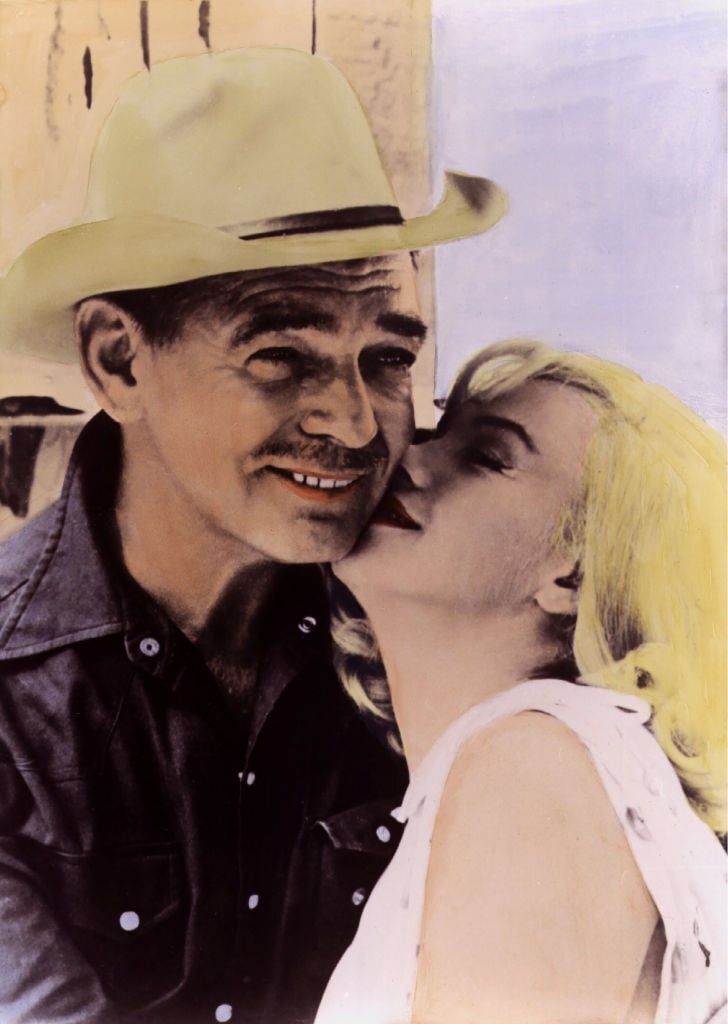
Sadly, Clark Gable had a fatal heart attack just days after The Misfits wrapped, which some attribute to the 59-year-old performing his own stunts. When he died, Marilyn wept for two days straight. By November 1960, Miller and Monroe announced that they had separated.
Suicidal Thoughts
In February 1961, Marilyn told a friend that she had thought about jumping off her apartment balcony. Soon, her psychoanalyst had her committed to a psychiatric ward. Believing she was going to a place to recuperate, the world’s most desirable woman was “forced into a padded cell and threatened with a straightjacket.” Forcibly institutionalized, Marilyn Monroe was diagnosed by two top psychiatrists as a paranoid schizophrenic just like her mother.
ADVERTISEMENT
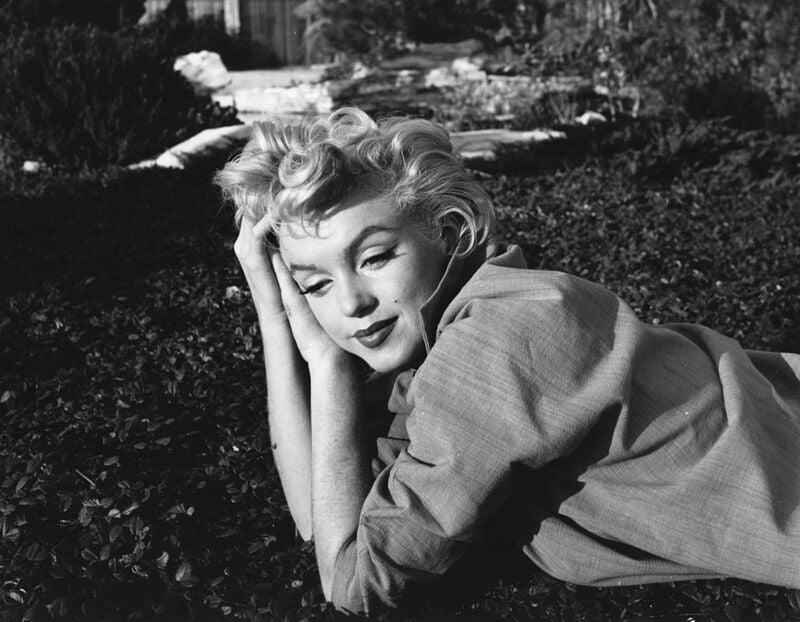
Poor Marilyn’s experience at the institution was one of the darkest, most harrowing, and humiliating moments of her short life. In recently uncovered letters, Marilyn wrote of the “inhumanity” of the psych ward and being treated as sub-human. In a desperate bid to escape, she smashed a pane of glass and threatened to hurt herself unless she was released. Finally, an unlikely knight in shining armor rescued her when ex-husband Joe DiMaggio got her released.
Something’s Got To Give
She signed on for Something’s Got To Give (1962) but didn’t show up for the first two weeks of filming as her descent into drink and drugs worsened. Her makeup artist would have to apply her makeup as she lay semi-comatose in her bed, addled by barbiturates. In the end, something had to give, and the studio fired Marilyn Monroe. The film remains unfinished but was made into a short film.

Monroe still had so much star power that Fox immediately about-turned, re-opened negotiations, and gave her a new contract, including re-commencing Something’s Got to Give and a starring role in a black comedy. Sadly, she’d never get to make another movie as her demons got the best of her. The name of the film she never got to make was What a Way to Go!
Happy Birthday, Mr. President!
Yet as Marilyn plunged into the abyss, she still had enough moxie to date Joe DiMaggio’s best friend, Frank Sinatra! Over the years, the blonde bombshell also reputedly slept with Satanist Anton LaVey, actor Jerry Lewis, filmmaker José Bolaños, Darryl F. Zanuck, Howard Hughes. But her most famous fling was with JFK, whom she met at one of his sisters, Pat Kennedy Lawford, and her husband, Peter’s sex parties.

In May 1962, she famously serenaded President John F. Kennedy at his 45th birthday party with her sexy, breathy version of “Happy Birthday”. So naturally, the press had a field day, launching rumors that the two were having an affair. Of course, those rumors were true, and it all culminated in a dramatic face-off with Jackie Kennedy.
First Lady
Christopher Andersen’s 2013 biography, In These Few Precious Days: The Final Year of Jack with Jackie, claims that Marilyn called Jackie Kennedy and told her that JFK had promised to marry her. As cool as a cucumber, the FLOTUS replied: “Marilyn, that’s great … you’ll move into the White House, and you’ll assume the responsibilities of First Lady, and you’ll have all the problems.”
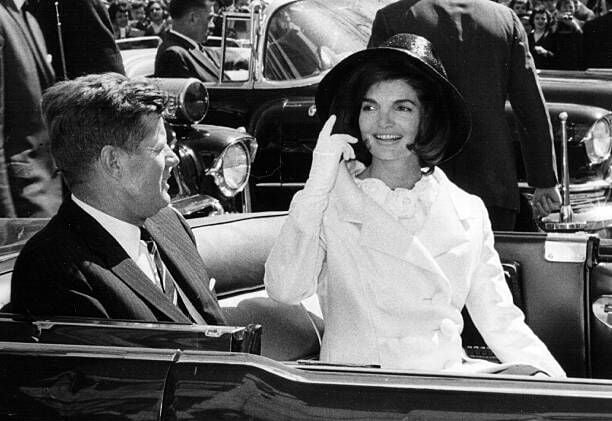
But Marilyn wasn’t just sleeping with JFK; she was also bedding his younger brother Bobby Kennedy. As her mental health declined further, she found herself depending on the two brothers, but their lofty positions meant they could show her no loyalty. Believing she’d finally found two father figures to take care of her, Monroe became increasingly convinced she’d marry one of the Kennedy brothers but they both abandoned her.
Driven to Despair
Being cast aside by both Kennedy brothers pushed Marilyn over the edge. She often stayed with the Lawfords and––high on pills–– would “wander into the couple’s bedroom in the middle of the night and stand at the foot of their bed, staring down at them. ‘Why can’t I be as happy as you two?’” She would ask them. Then, mere days before she died, Monroe told a close friend, “If it weren’t for Joe, I’d probably have killed myself years ago.”
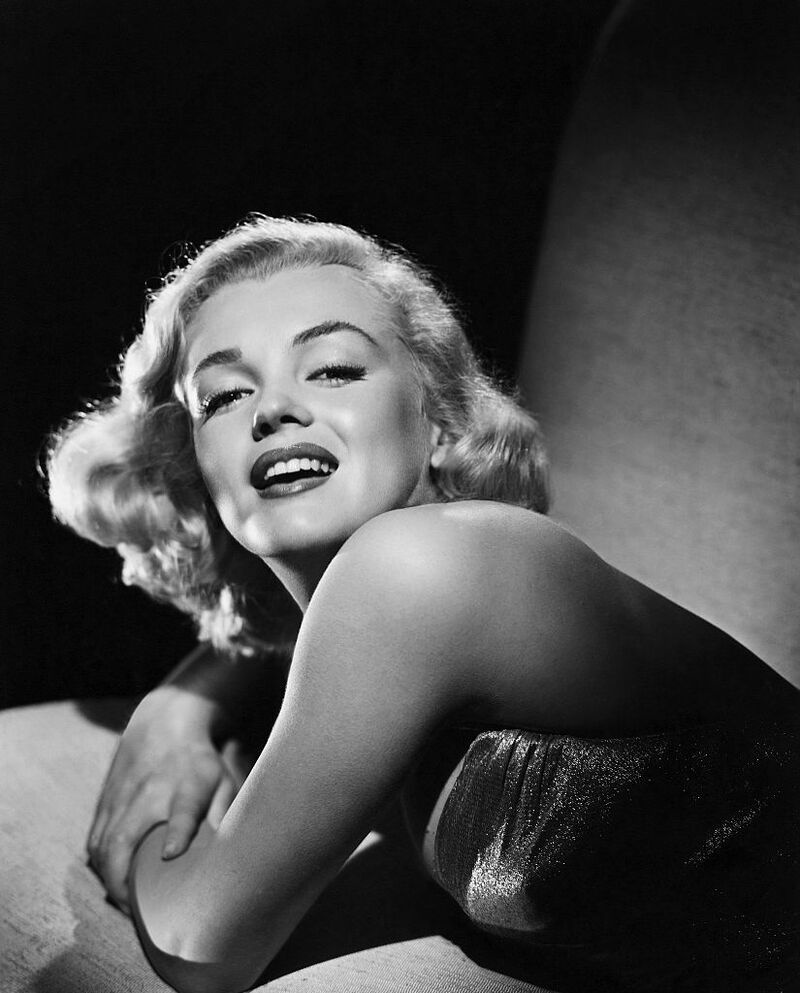
On August 3rd, 1962, an upcoming young actor named Warren Beatty was allegedly one of the last people to ever see Marilyn Monroe alive. The 25-year-old met Marilyn at a producer’s house during a party. In a 2016 interview, the lothario revealed he and Monroe spent the evening together. He played the piano for her, and the pair took a moonlit walk along the shore. Marilyn Monroe reportedly spent her last night alive with mafia boss Sam Giancana, whom she was dating.
Death
On August 5th, 1962, Marilyn Monroe’s body was discovered at her home in Brentwood, Los Angeles, by her psychologist. She was just 36 years old. She was found in her bed with her phone in her hands. Peter Lawford took a call from her that night and knew something was very wrong when, with slurred speech, she said “’Say goodbye to Pat, say goodbye to Jack (President John F. Kennedy) and say goodbye to yourself, because you’re a nice guy.” They would be the last words he heard from her. He was desperate to check in on her but was talked out of it, due to the potential political ramifications.
ADVERTISEMENT
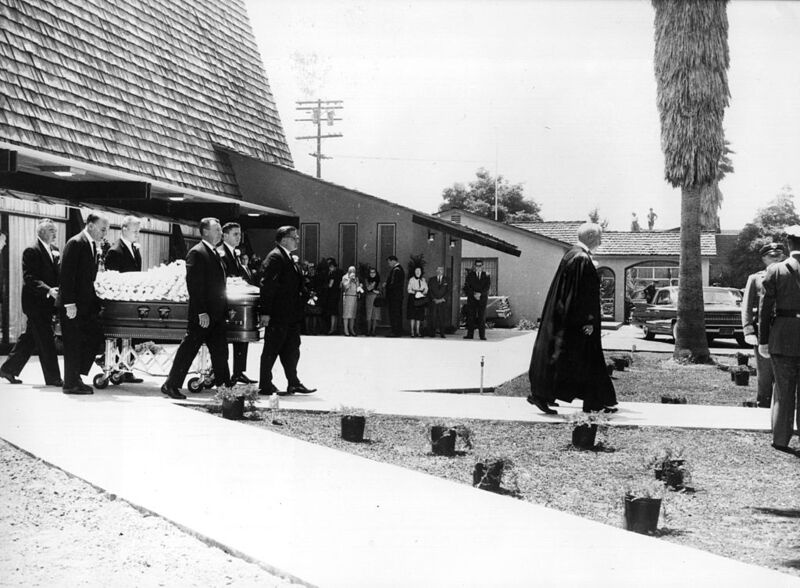
With many times the lethal limit in her body, the coroner stated Marilyn Monroe had committed suicide by overdosing on barbiturates. Conspiracy theories surround her death to this day, and even her ex-lover Marlon Brando believed she was murdered. The most famous conspiracy is that the Kennedys and/or the CIA, or even the Mafia, killed her and staged a suicide. The Kennedys certainly had a motive. This is what the autopsy report had to say.
Her Body Was Abandoned
After Marilyn Monroe passed away, her body was reportedly left alone and unclaimed in the mortuary for more than 24 hours. Her ex-husband, Joe DiMaggio, eventually came to claim her body. Allan Abbott, who was in charge of the funeral service for the actress, later described how “almost unrecognizable” Marilyn looked after her death.
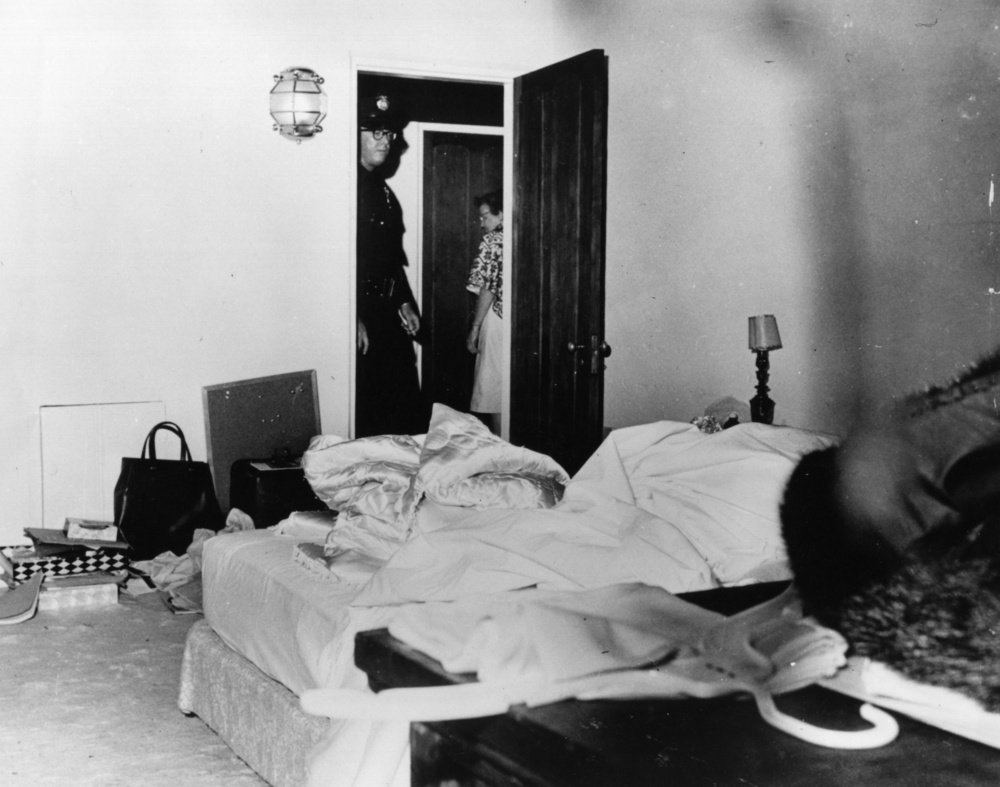
“When we removed the sheet covering her, it was almost impossible to believe this was the body of Marilyn Monroe,” Abbot described. “She looked like a very average, aging woman who had not been taking very good care of herself. “Obviously, the circumstances surrounding her death had greatly exacerbated her poor appearance and she was unrecognizable.”
Funeral
French artist Jean Cocteau stated Marilyn’s untimely death “should serve as a terrible lesson to all those whose chief occupation consists of spying on and tormenting film stars”. Former co-star Laurence Olivier said she was “the complete victim of ballyhoo and sensation,” and Bus Stop director Joshua Logan called Marilyn: “one of the most unappreciated people in the world.”
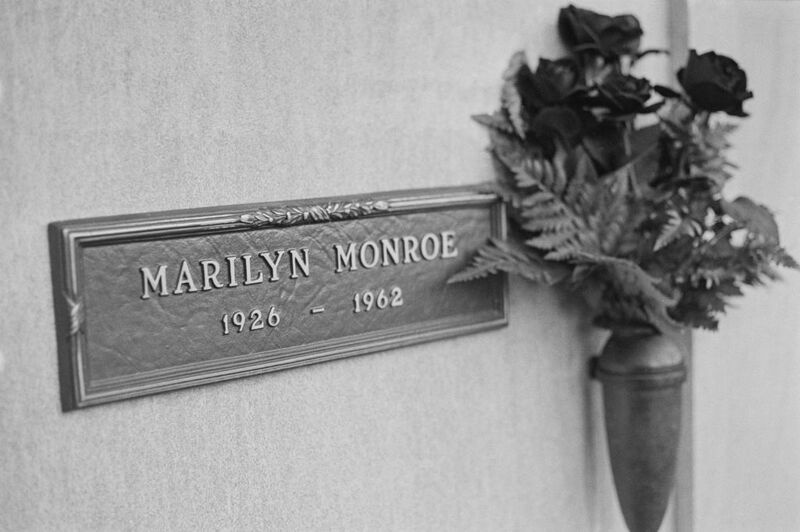
Her funeral was held at the Westwood Village Memorial Park Cemetery, Los Angeles, and arranged by Joe DiMaggio, her half-sister Berniece and business manager Inez Melson. Inside the open casket, she wore an apple green dress and held pink roses. Sadly, because her signature platinum blonde hair had been partially shaved for the autopsy, she sported a wig. Only around 30 people saw Monroe lying in her coffin because her funeral was limited to her close friends and family.
Good Old Joe
Speaking of Joe DiMaggio, remember the night he obsessively stalked Marilyn, and he and Sinatra kicked down the door of an innocent middle-aged secretary? Well, to Joe’s credit, this dark episode scared him so much he confronted his demons, stopped drinking, and started anger management therapy. Eventually, he and Monroe became close friends, and when she died, he was heartbroken. However, Joe always believed he and his ex-wife would one day reconcile and be together again, and rumors suggest they’d rekindled their love just weeks before her demise.
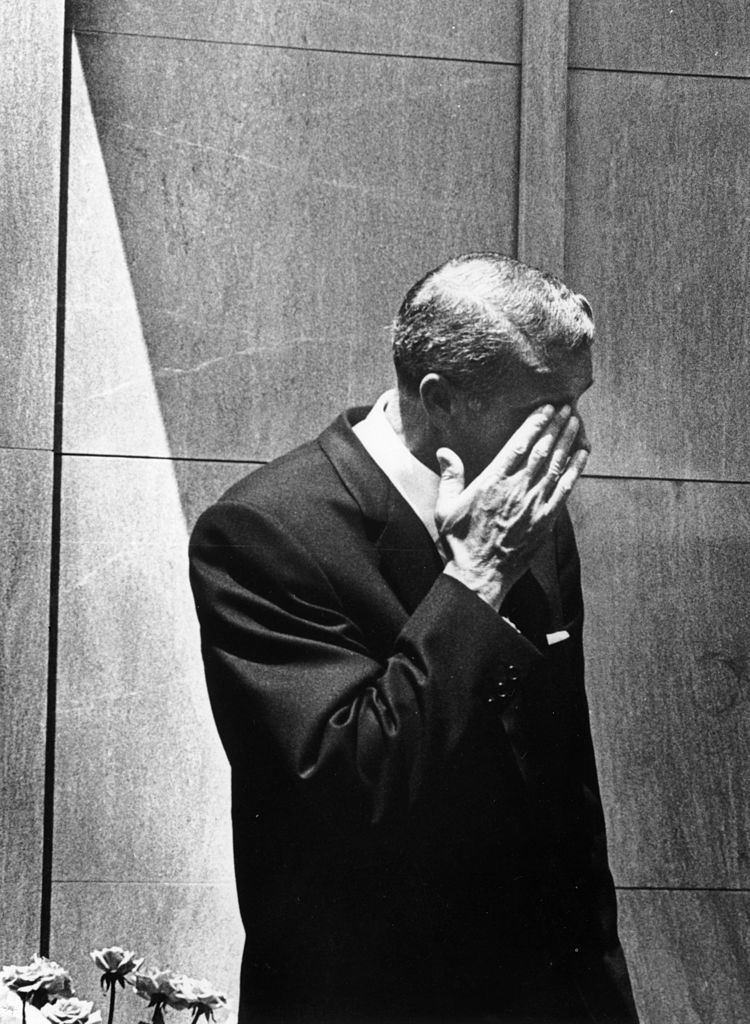
For twenty years after Marilyn died, Joe DiMaggio sent roses to her crypt three times a week. Despite the fact Joe outlived his beau by 36 years, he never re-married. He never got over Marilyn Monroe, and legend says his final words were apparently, “I’ll finally get to see Marilyn.”
Legacy
In the decades since she died, many artists have paid sweet tributes to Marilyn, notably Elton John’s “Candle in The Wind” and the many homages to Marilyn’s “Diamonds Are A Girl’s Best Friend”. However, while Madonna based her entire schtick on Monroe, some other accolades are just plain creepy. For instance, did you know Playboy founder Hugh Hefner bought the crypt next to Monroe’s grave?
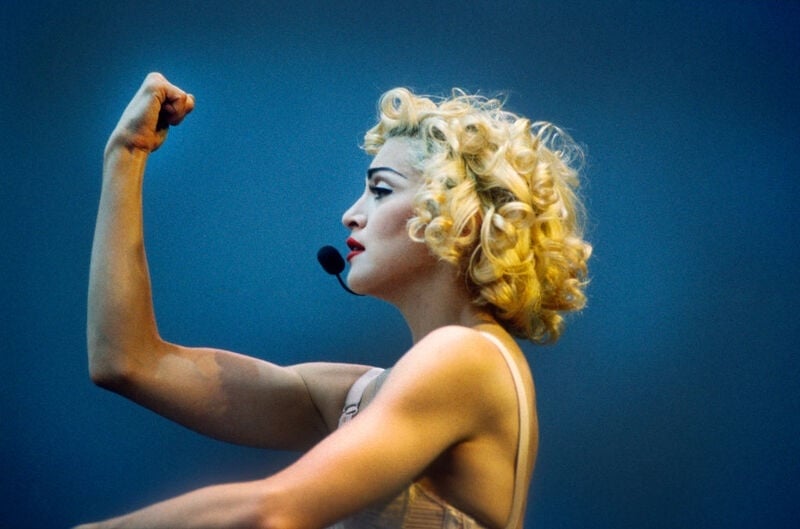
Other tributes were just plain rude! Her ex, Arthur Miller’s 1964 play After the Fall, is a blatant portrayal of his time with Marilyn. And it wasn’t exactly a tribute. Iconic writer and civil rights hero James Baldwin walked out of the show saying that the character, Maggie––clearly based on Monroe––was written so cruelly.
One Final Dark Secret
Her ex-lover, John F. Kennedy, was assassinated in 1963, and Bobby Kennedy was assassinated in 1968. But that didn’t stop more bombshell revelations of conspiracy theories, intrigue, and cover-ups. In 1972, actress Veronica Hamel bought Marilyn’s old home, and when she renovated the house, she made a shocking discovery.

Hamel uncovered an extensive system of telephone wires. Upon further investigation, these wires turned out to be wire-taps. No one knows if the CIA, the FBI, or even Joe DiMaggio had bugged Marilyn’s home with help from Frank Sinatra and their Mafia connections. Maybe those voices she heard over the years weren’t in her head, after all. Perhaps they were the CIA tapping her phone.
Phone: +2348029115783
WhatsApp: +2347037611903
Follow us via:
Facebook: @Words and Shots
Instagram: @words_and_shots
Twitter: @wordsandshots

History of Abuja

THE LONGEST BOXING FIGHT IN HISTORY

DEADLY CROWD CRUSH DURING SALE OF SEIZED RICE IN NIGERIA

GIGANTIC NEW SNAKE SPECIES DISCOVERED IN AMAZON RAIN FOREST

SHE DIED SAVING HER CHILDREN FROM FIRE AND GAVE LIFE TO 8 MORE PEOPLE THROUGH HER ORGAN

THE TALIBAN EXECUTES TWO MEN BY SHOOTING THEM AT THE SPINE

HE’S FINALLY BACK! Ronaldo Returns To Manchester United After 12 Years

ISIS POSES ‘ACUTE’ THREAT TO U.S. Evacuation Efforts in Kabul, Sullivan Says

Book Review

FEDPOLY OHODO: Renovation Commences In Full

WHY IS THE LEGENDARY RPG-7 STILL IN USE?

KEVIN COSTNER OPENS UP ABOUT HIS PAST Relationships And How He Met His Soulmate

[ROCK ‘N’ ROLL] THE STORY BEHIND SIMON AND GARFUNKEL’S THE SOUNDS OF SILENCE

REMEMBERING THE ORIENTAL BROTHERS INTERNATIONAL BAND

MEET CHIKA UCHE-EKWE WHOSE VIRTUE INSPIRED PATTY OBASSEY’S SONG, EZINWANYI DI UKO

Couple’s Fight (Clean House Comedy)

Who Was Patty Obassey?
Trending
-

 Sports3 years ago
Sports3 years agoHE’S FINALLY BACK! Ronaldo Returns To Manchester United After 12 Years
-

 Foreign3 years ago
Foreign3 years agoISIS POSES ‘ACUTE’ THREAT TO U.S. Evacuation Efforts in Kabul, Sullivan Says
-

 Arts3 years ago
Arts3 years agoBook Review
-

 News3 years ago
News3 years agoFEDPOLY OHODO: Renovation Commences In Full
-

 History2 years ago
History2 years agoWHY IS THE LEGENDARY RPG-7 STILL IN USE?
-
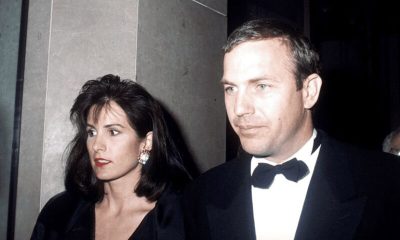
 Entertainment2 years ago
Entertainment2 years agoKEVIN COSTNER OPENS UP ABOUT HIS PAST Relationships And How He Met His Soulmate
-

 Entertainment3 years ago
Entertainment3 years agoMEET CHIKA UCHE-EKWE WHOSE VIRTUE INSPIRED PATTY OBASSEY’S SONG, EZINWANYI DI UKO
-

 People & Personalities3 years ago
People & Personalities3 years agoSAYING FIRST HAPPY BIRTHDAY TO DAD After 21 Years, Emotional – Beauty Queen
